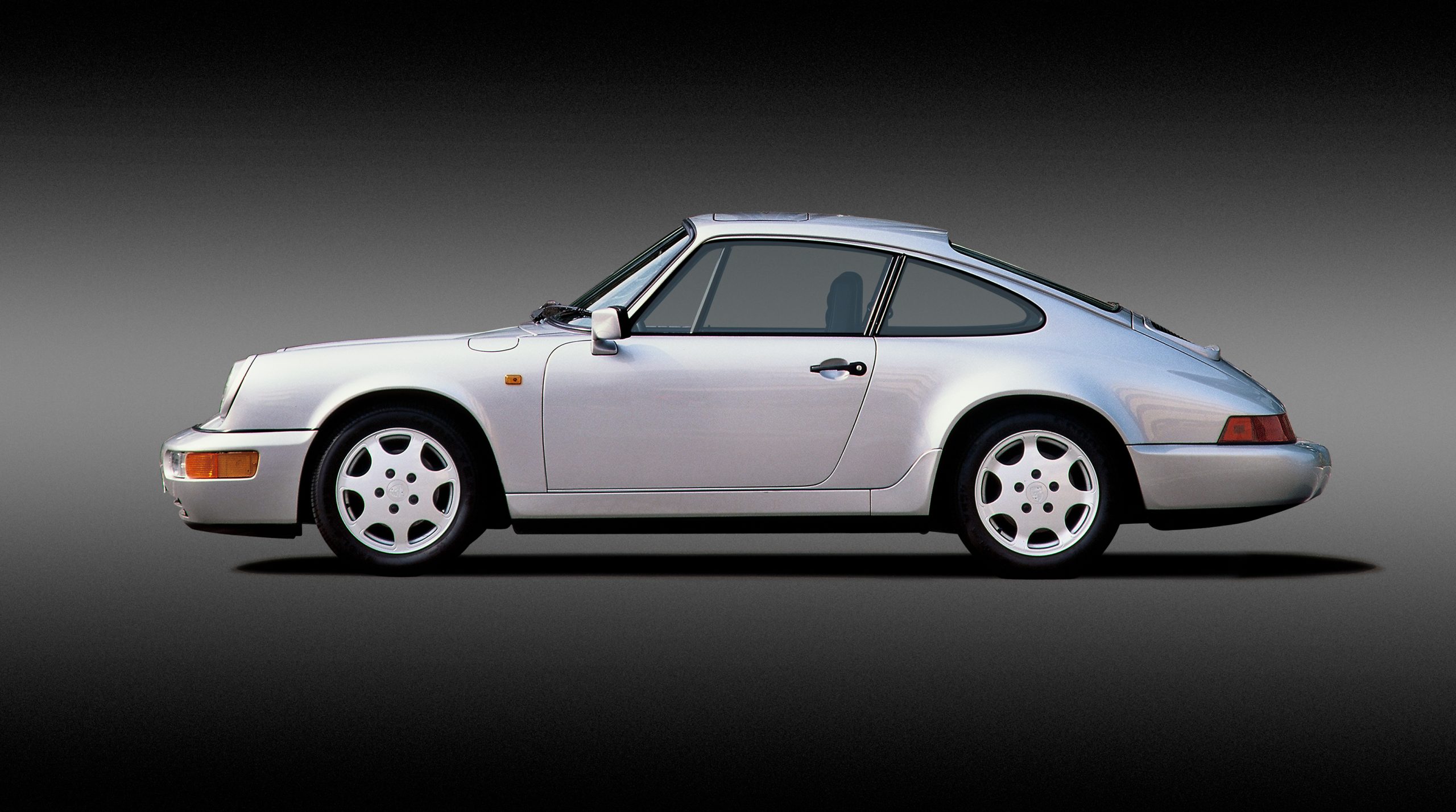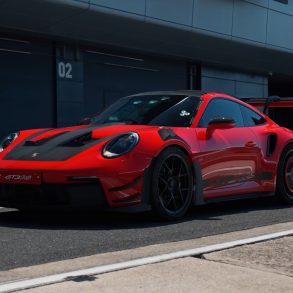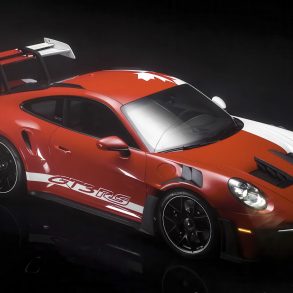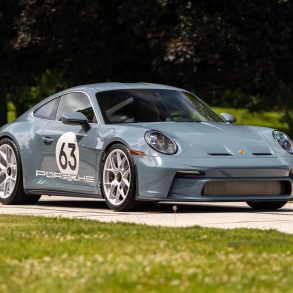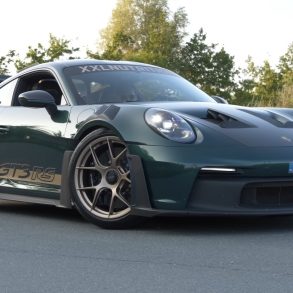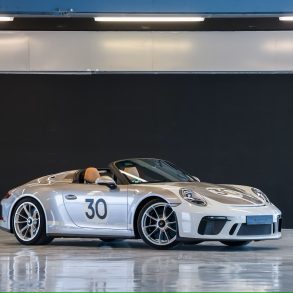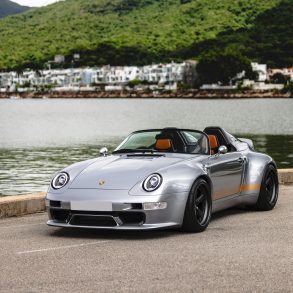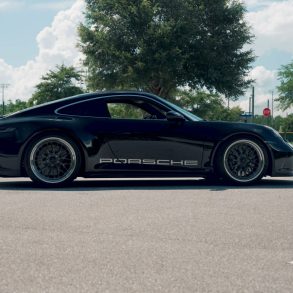Porsche 911 (964) (1988 – 1994) Story & History
Type 964 – The 3rd Generation Porsche 911
Premiere: 1988 September 28 at Mondial de l’Automobile Paris motor show
After the 1984 model year 911 Carrera 3.2 had entered the markets, the plans for the next generation 911 were set. In March-April 1984 the future 911 Carrera was internally designated as project 964 and the successor to the 911 Turbo as project 965. Although the 964-generation 911 didn’t look very different compared to the previous G-model 911, the 964 was a new car in many ways. Visually new were the bumpers, side sills, rear lamp panel and rear spoiler – the design work of Benjamin Dimson. He was the lead exterior designer of the 944 Turbo, 928 S4, 959, 911 Speedster and the 911 964.
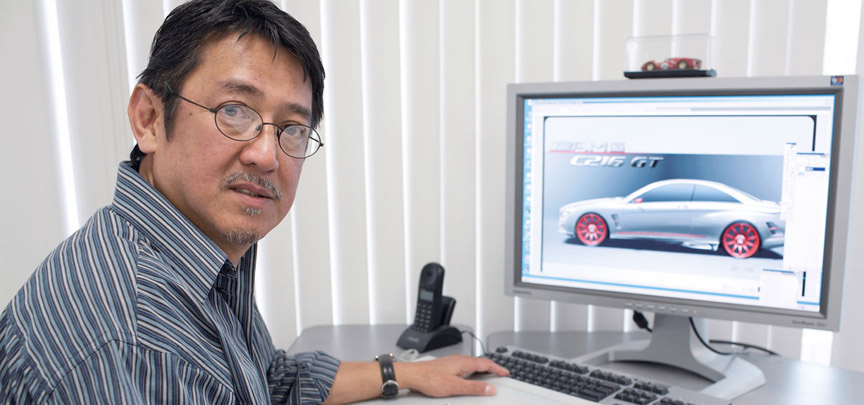
Porsche unveiled the 964 photos in July 1988, presented the car in autumn in Paris and first journalists got to test drive it in November. While the project 964 was ready and very well received, Porsche was really struggling with the project 965.
The first modification of the 964 introduced was the 4-wheel-drive Carrera 4. In normal driving conditions it has 31% of the drive force on the front axle and 69% on the rear axle. For slippery surfaces the axles can be locked (50% front/50% rear).
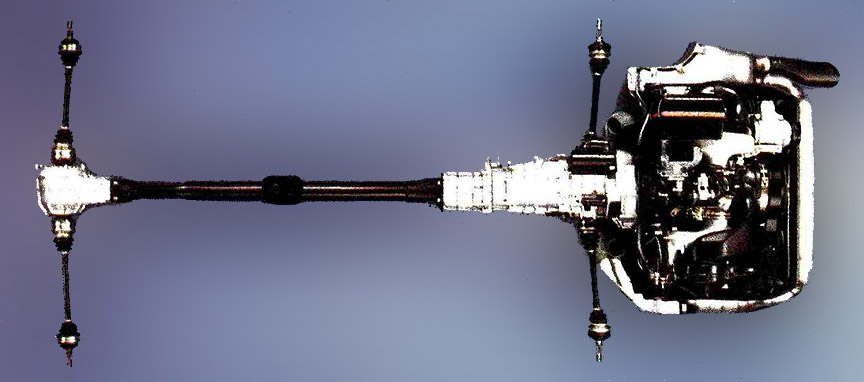
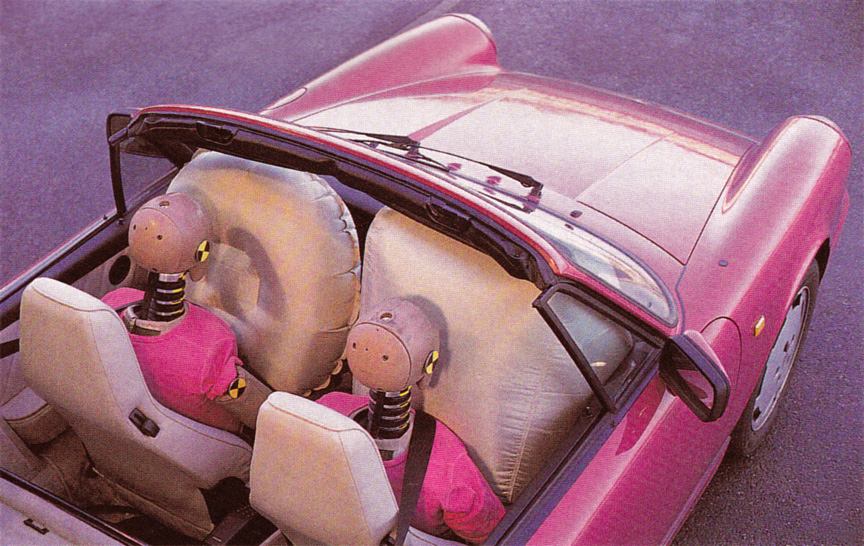

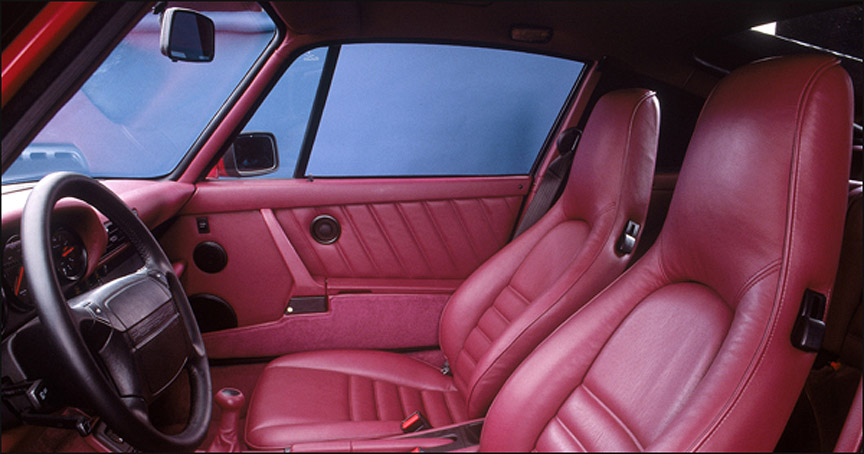
The 3.6-litre dual ignition 12 spark plug engine was new. It got 184 kW, the same amount the 944 Turbo had. The 964 C4 costed 37% more than the Carrera 3.2, but was still considered a bargain compared to the ancient G-model 911. Compared to the outgoing 170 kW-version Carrera 3.2, the 964 Carrera 3.6 had 14 kW more, but was soon to be found not so durable as the 3.2-litre. With the new 964 Porsche tested building engines without gaskets between cylinders and heads. The aluminium on aluminium contact proved to be a bad idea as it wasn’t strong enough to withstand the combustion pressure and the cylinders started to leak. Not much, but still. Unfortunately, there was no easy fix to this problem as it was not possible to install gaskets on these early engines.
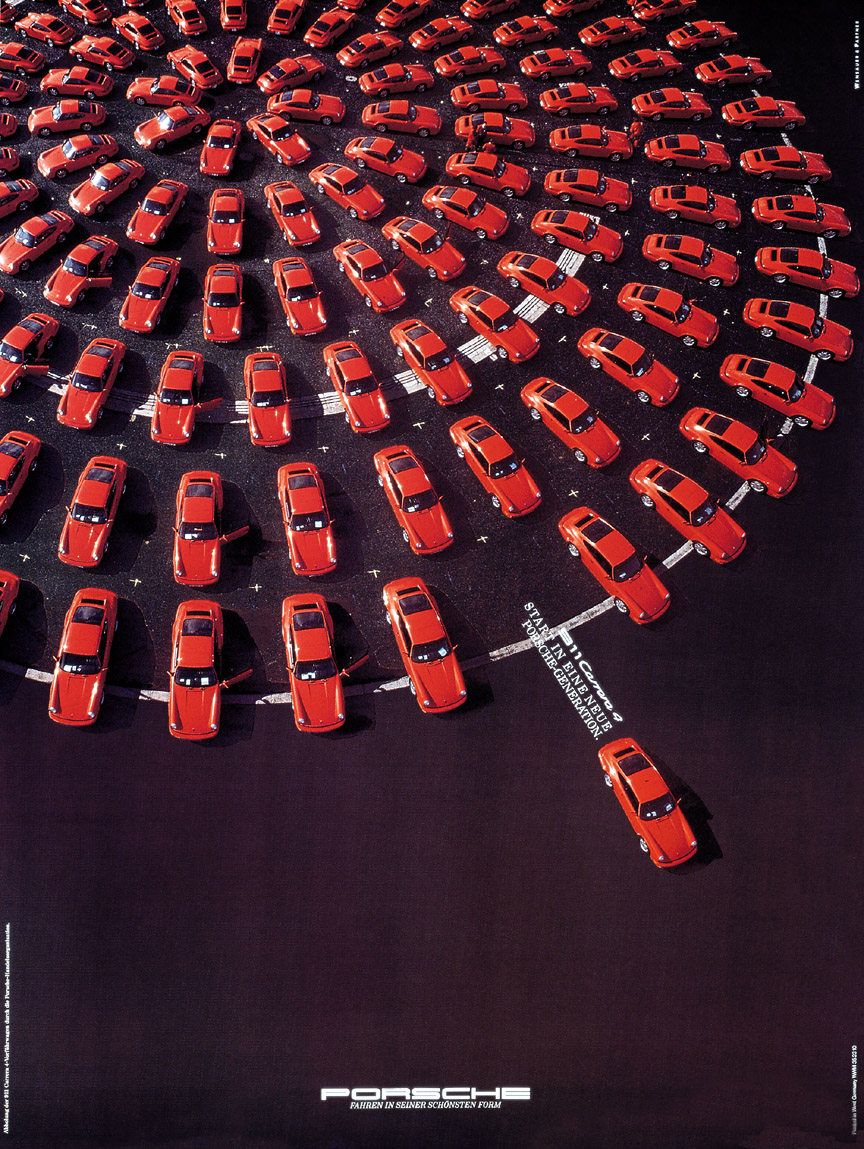

The cabin heater in the G-model was so out of date that the new heating system in the 964 could be a reason enough to prefer 964 over the pullet-proof G-model Carrera 3.2. The torsion bar suspension found in the earlier 911 was also replaced by more conventional springs. The ABS brakes became standard and the 964 got the power steering.
For some period the rear-wheel-drive G-models with their bodies made in the old body plant and the 4WD 964s with their bodies made in the new body plant, were produced in parallel and the RWD 964 Carrera 2 was introduced a bit later as a 1990 model. Thanks to saved weight (-100 kg/220 lb) and rear-wheel-drive the Carrera 2 was more fun to drive, more Porsche. The Carrera 4 was mostly the product of the marketing department as “4WD” was the magic combination in the end of the eighties and nobody really cared that the rear engined car with no weight on the front axle, cannot benefit from the drive force on front wheels. The 911s had always had the traction comparable to 4WD cars thanks to the engine putting more force on the rear axle the harder the driver accelerated. The second minus later found with the Carrera 4 was its braking system that didn’t last and the cardan shaft that started to make noise when the car got old. The first model year (1989) 964 had a few differences compared to the later cars: ClubSport wheels (known from 928 S4 CS), electric rear spoiler with automatic up-and-down only (there was no switch for it), rear seat belts were manual (not yet automatic) and the catalyst was optional (not standard yet).
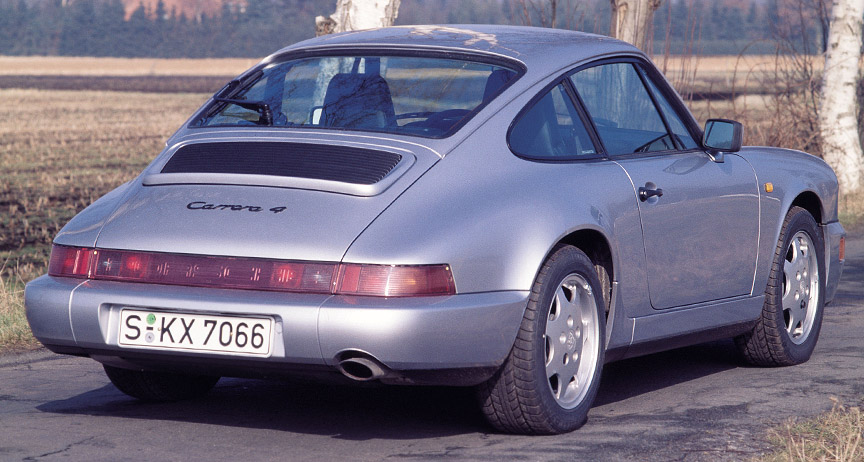
In 1989, for 1990 model year the Cabriolet and Targa body variants were also introduced in addition to rear-wheel-drive. For the RWD cars the Tiptronic gearbox was introduced, too. So, now you could choose between 9 combinations of body, drivetrain and gearbox: C2 Coupé/Targa/Cabriolet with 5-speed manual or 4-speed Tiptronic and C4 Coupé/Targa/Cabriolet with manual.
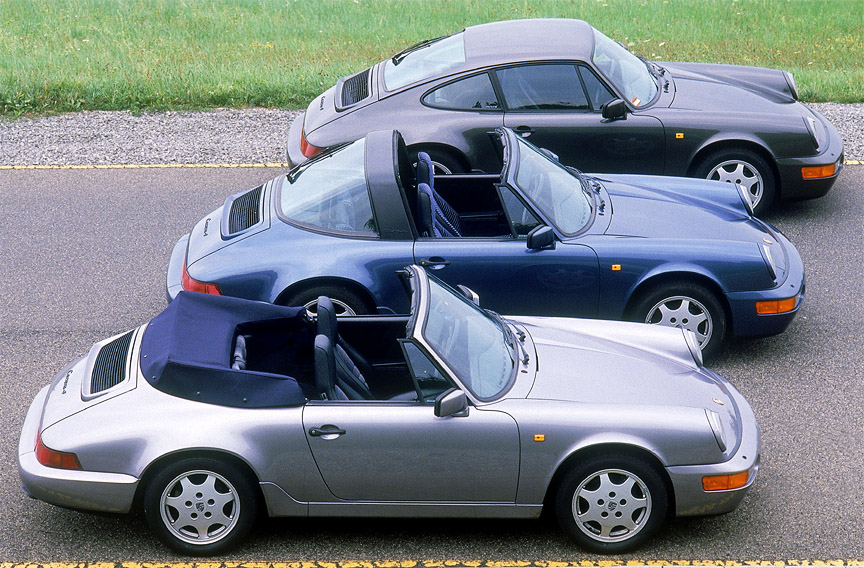
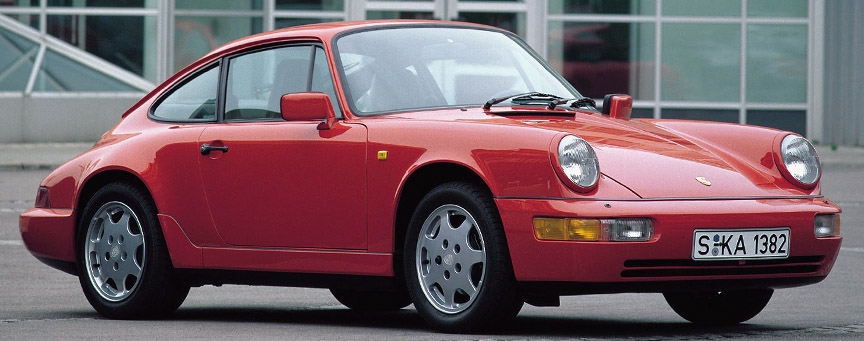
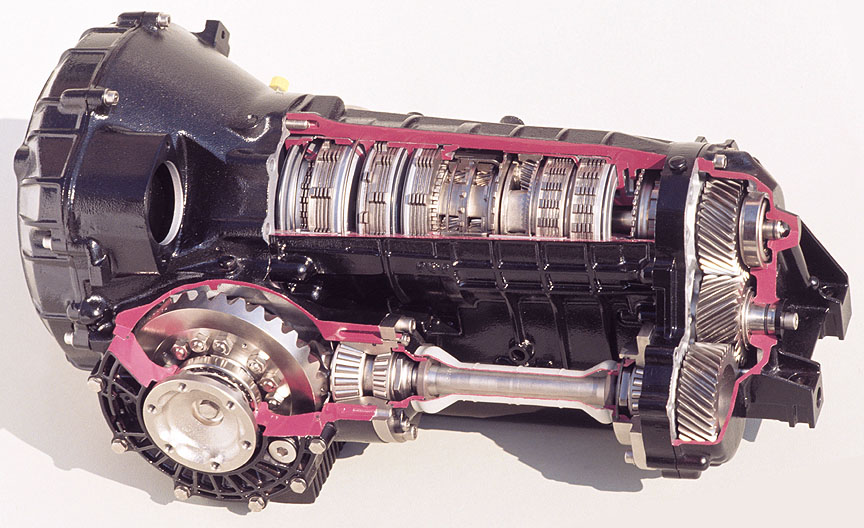
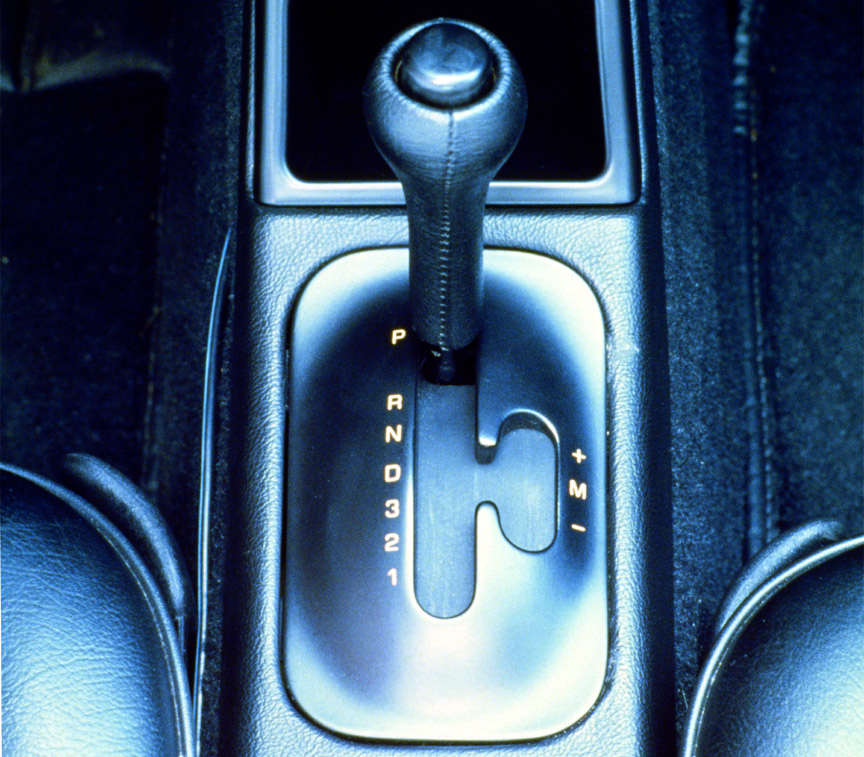
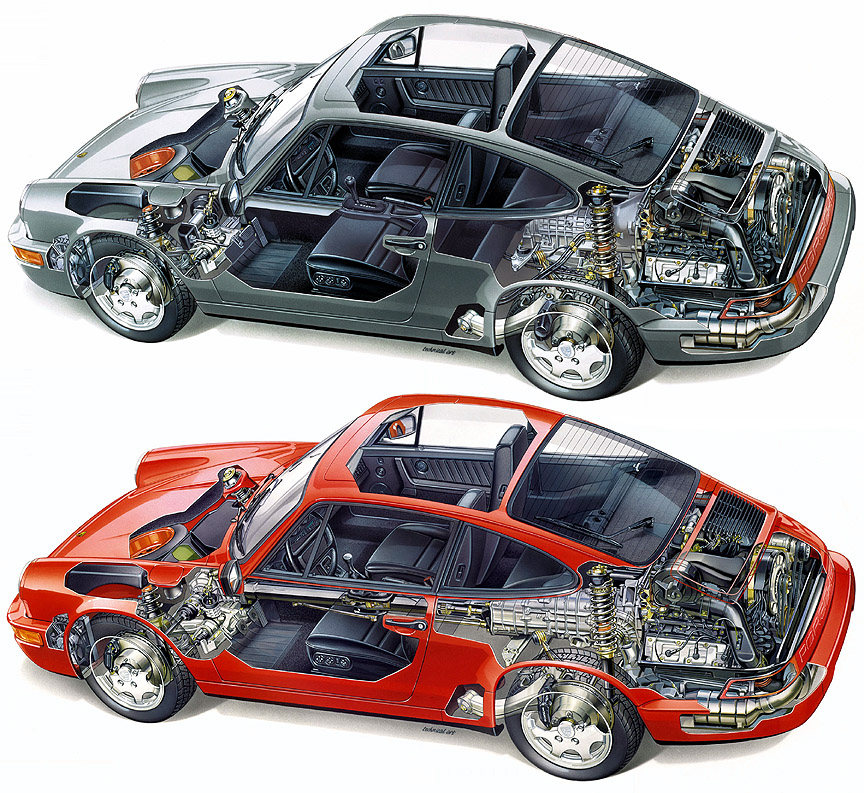
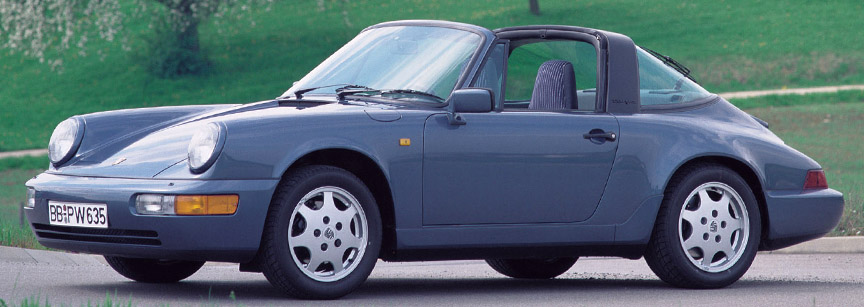
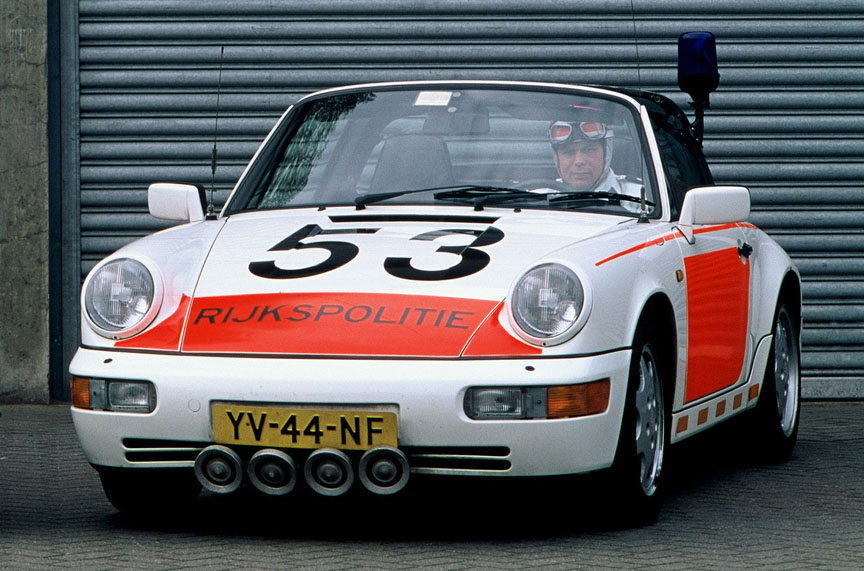
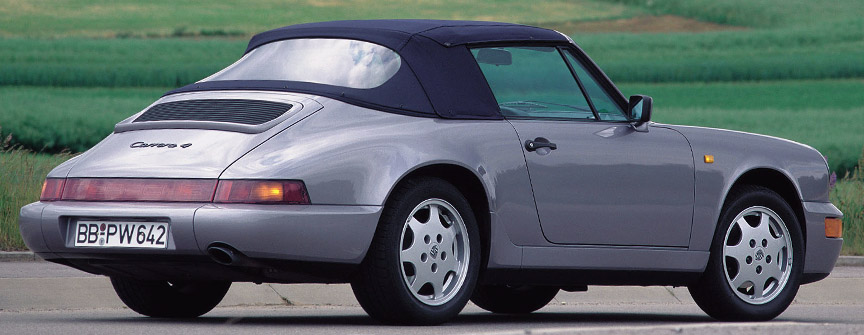
Porsche had ran a one make championship with 944 Turbos from 1986 to 1989 and switched to 964s from 1990 season. This initiated the birth of the Carrera Cup series and 911 Carrera Cup cars. These lightweight cars based on Carrera 2 had to sacrifice even the power steering that was just introduced to 964 street models. Power was up by 11 kW (195 kW).
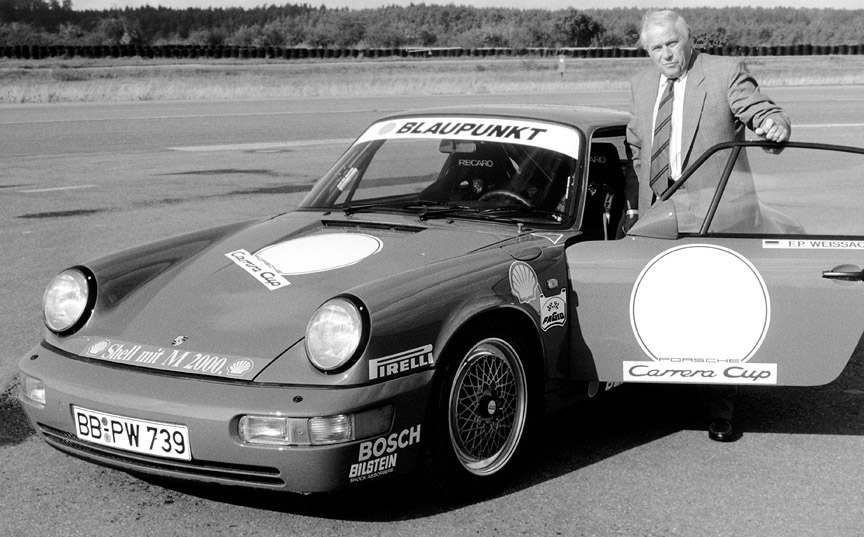
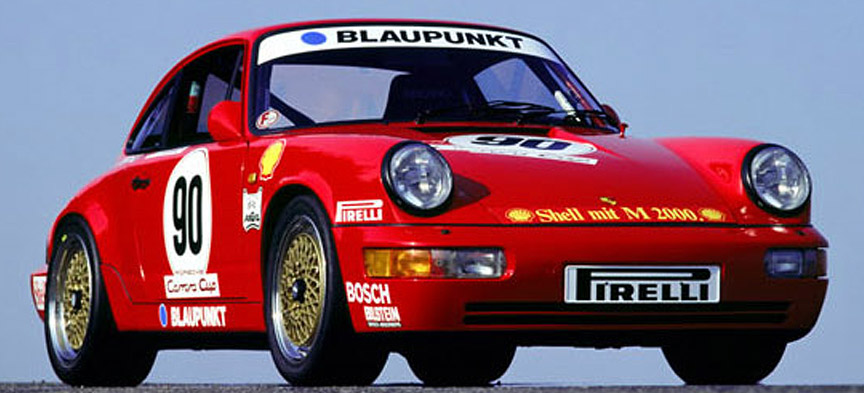
The only visual difference between the 964 Cup prototype shown in 1989 and the actual racing car of the 1990 were the wheels. The 1990 racing car got 5-spoke 17″ wheels, later referred to as Cup 1 wheels. For the Carrera Cup car they were made of magnesium, which is 1/3 lighter than aluminium.
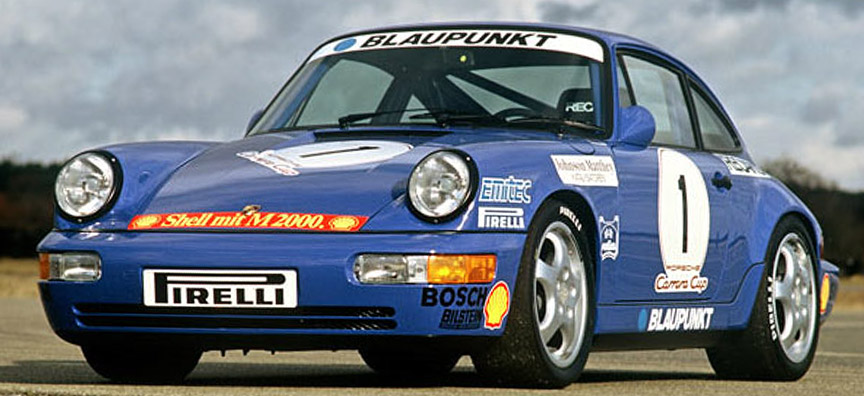

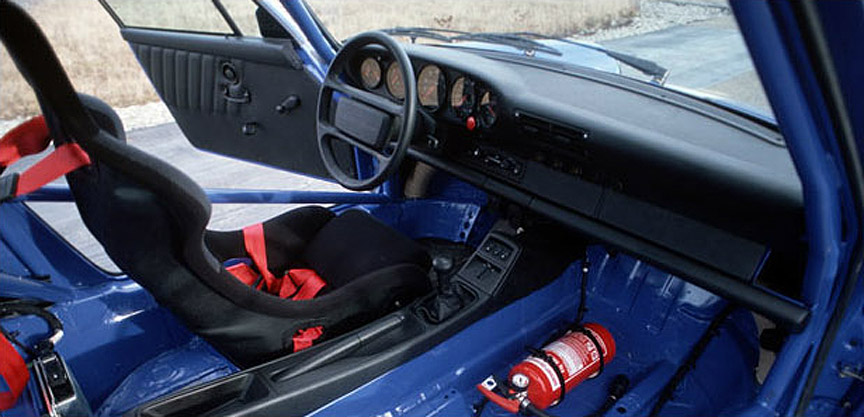
In 1990 the Carrera Cup was ran only in Germany (France still continuing 944 Turbo Cup for 1990) and the first season was won by Olaf Manthey, a Porsche-person who doesn’t need introduction.
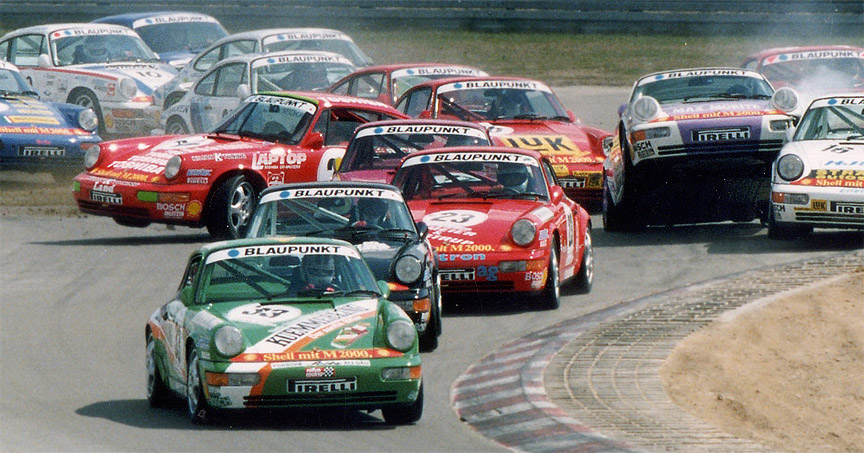
From September 1990 one strange model was available for wealthy customers of Porsche Motorsport. Called the 964 C4 Lightweight (or Leichtbau in German), the car was hand built in Weissach under the direction of the customer sports department leader and Le Mans winner Jürgen Barth. As the car used many exotic components, it came out very expensive (more than two times the price of the Carrera Cup car), so it wasn’t interesting for the racers anymore. It was built as a race car and couldn’t be registered for street traffic – instead of the 17-digit VIN, the 964 C4 Lightweights have 6-digit chassis numbers (964001 etc.). There were no customers for C4 Lightweight and only 20-22 were made in total, for collectors.
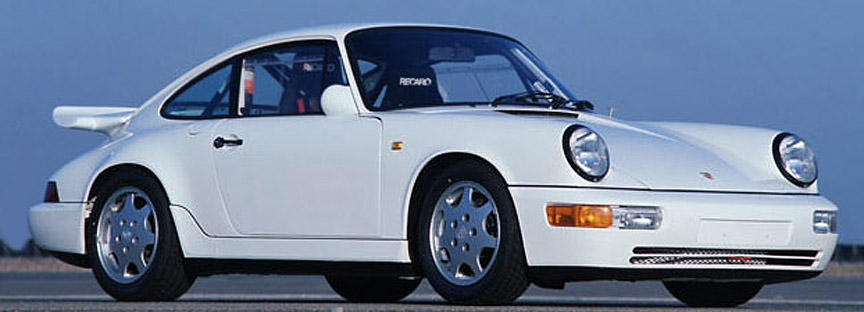
Weight was saved eveywhere. To mention a few spots, the fixed rear wing was made of Kevlar, the doors and trunk cover of aluminium and windows of Plexiglass. Power steering was deleted. At around 1100 kg /2425 lb the car was 350 kg / 771 lb lighter than the street legal Carrera 4. Unbelievable and respectable achievement.
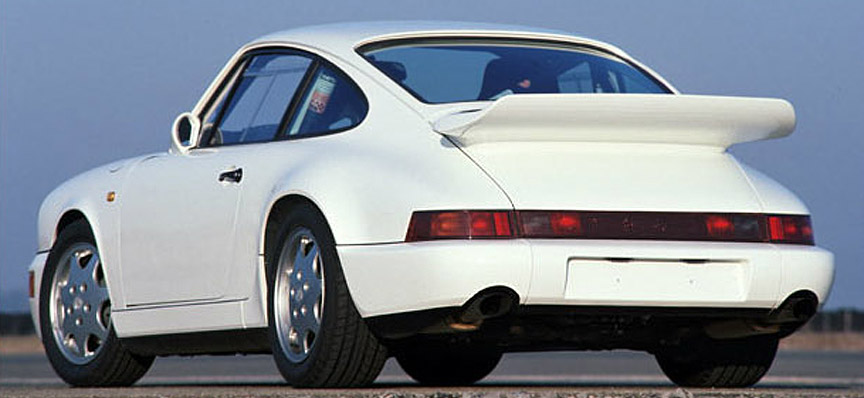
If the 964 C4 L would have had offroad suspension, it would have been a successor to the Porsche 953 (911 Carrera 3.2 4×4 Paris-Dakar rally car) as it has the 953 4WD and short-ratio gearbox that was geared for 210 kmh/130 mph in fifth gear. But as the lowered suspension was taken from the Carrera Cup car, it could only be used on the race track. Why would you want to have 4WD on tarmac in a rear-engined car? And there’s not enough speed for the fast tracks with 953 gearing and you wouldn’t feel confident racing a car with lightweight aluminium rollbar anyway. So, it is a collectable, not a car for racing. The cars were built over two year period (averagely not even a car per month) and each one was unique in details.
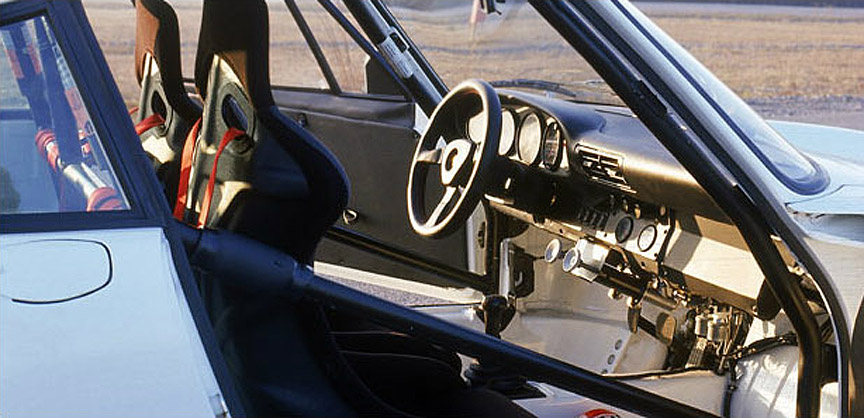
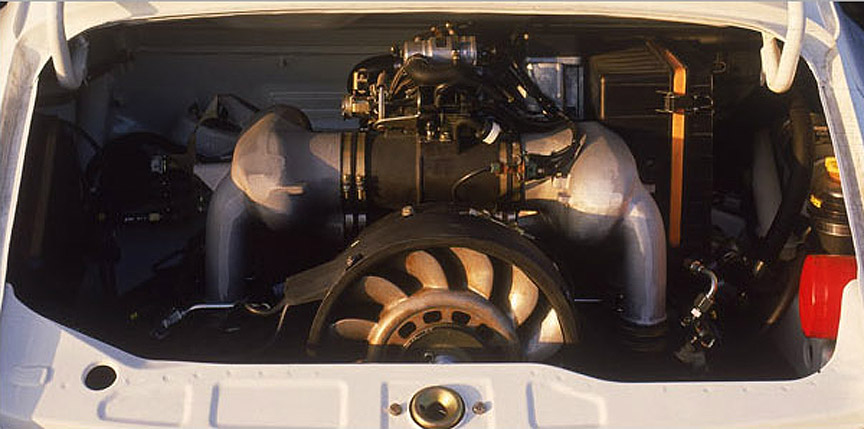
Porsche had started to develop the successor to the 911 G-model Turbo already in 1984 under the code name of 965, but the project was not meant to be an easy one. The plan was to stop 911 Turbo after G-model and to make a completely new high-end model with 4WD, almost as extreme as 959, but cheaper.

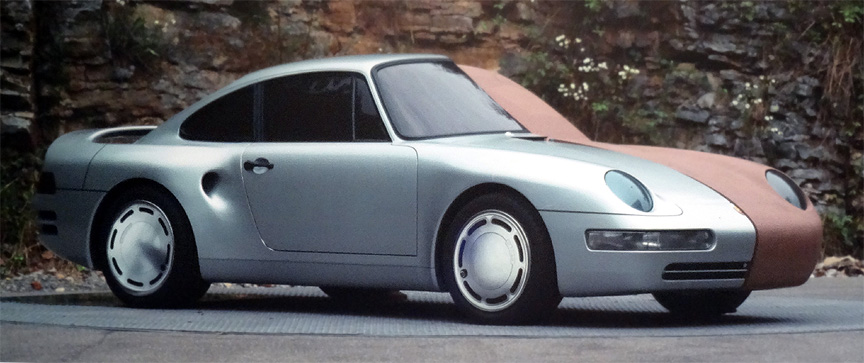
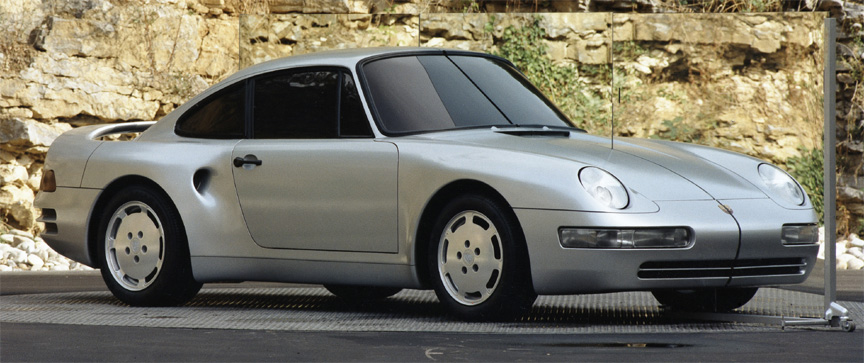
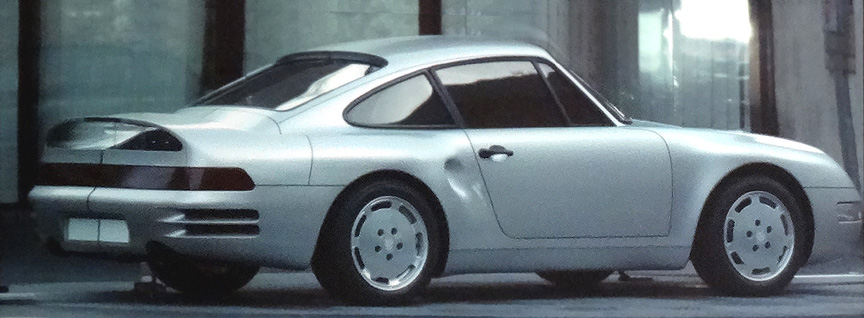
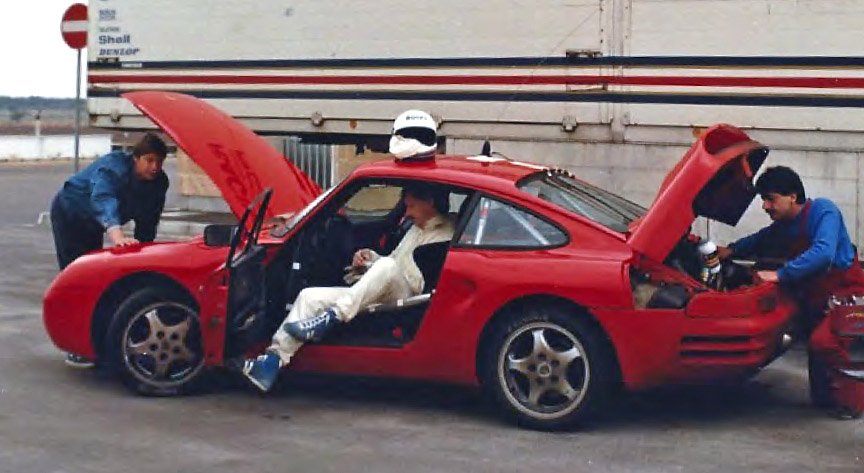
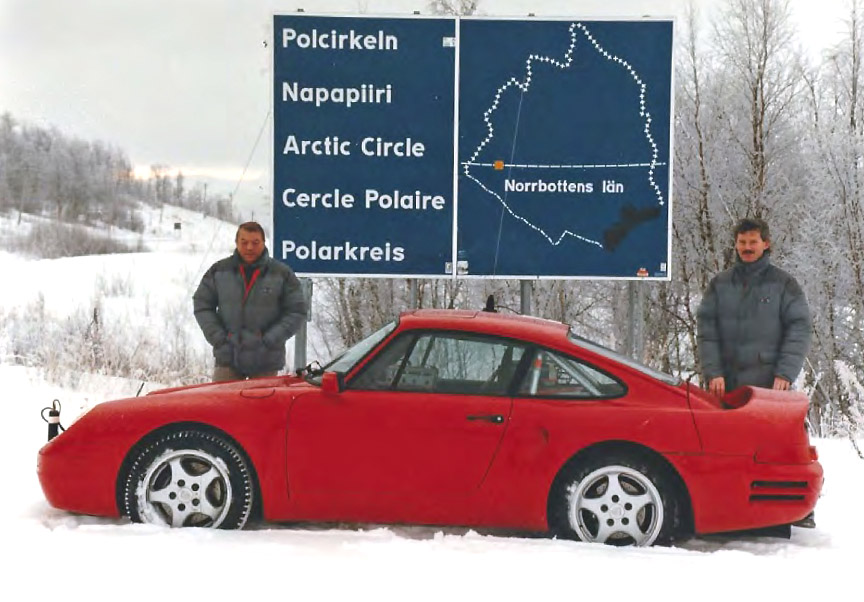
As the project had followed the design lines of the 959, in May 1988 it was decided that the 965 will enter the markets in 1990 as a Porsche 969. Unfortunately, in December 1988, it was clear that the 969 would be too expensive and they were also unable to decide what engine should it have. A watercooled flat-6 3.4-litre bi-turbo with EFI and 350 PS (257 kW) was on the table and even the V6 and V8 were considered. The PDK (Porsche DoppelKupplung) double-clutch gearbox was considered as an option.
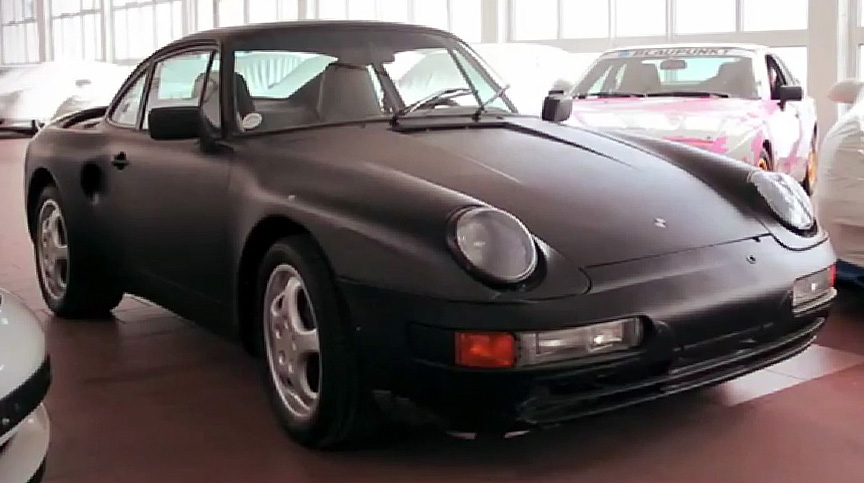
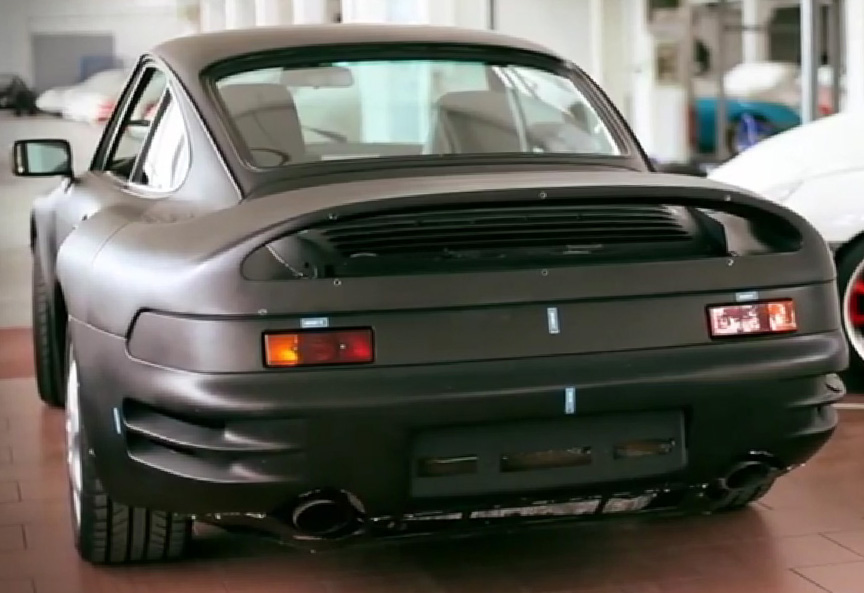
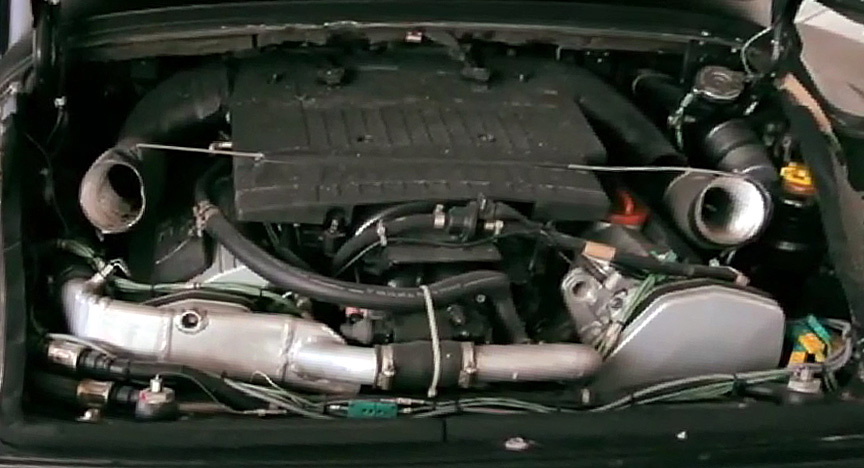
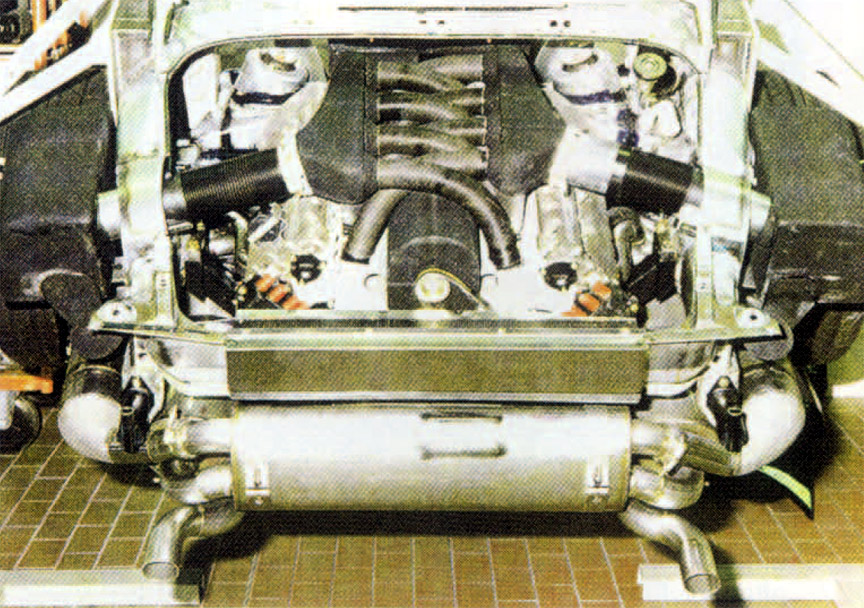
The engineers ran out of time while Porsche already needed to make money with the replacement of the G-model Turbo. Although a long way was travelled, everything was shed aside and the new top of the line model was made based on the 964.
Porsche introduced the 964 Turbo at the Geneva Motor Show in March 1990. Unfortunately, they had kept the old K-Jetronic 3.3-litre engine of the 911 Turbo G-model. Like the prototype, the production model was also internally called the 965. You cannot read it from the VIN, like with many other Porsches, but the spare part codes start with 965. Despite the production 965 wasn’t anything the engineers planned years before, its design later earned the status of the Porschest Porsche. The car had new aerodynamic mirrors, that would also become trademark items.
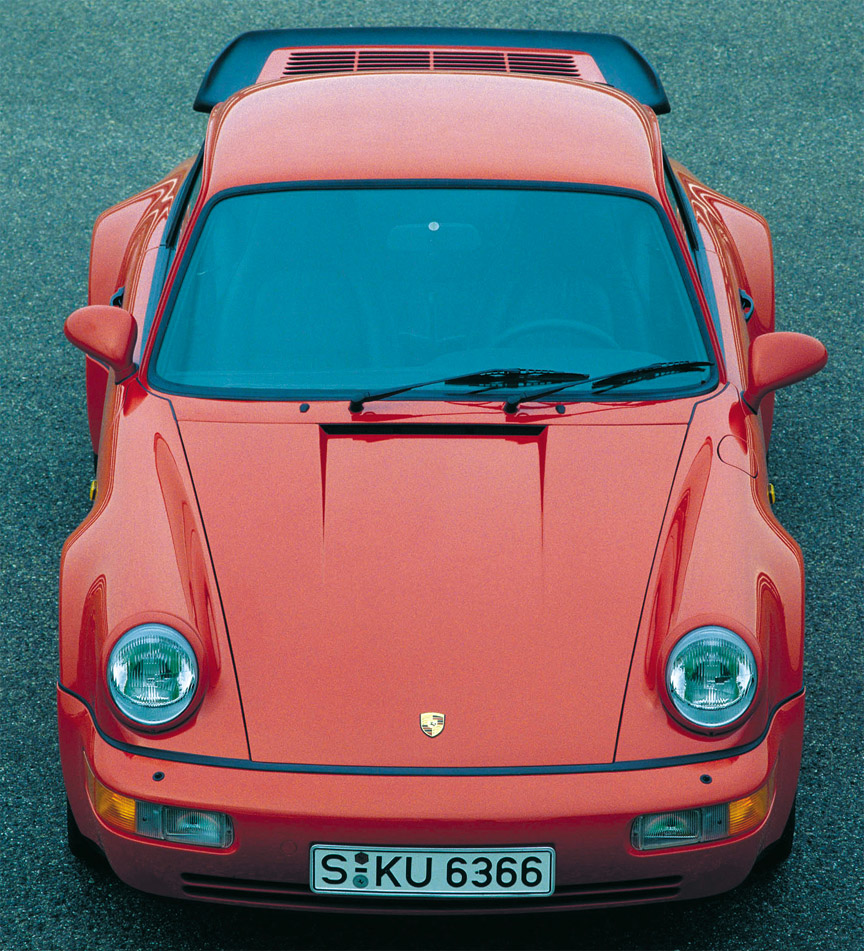
The 17″ wheels on the Turbo got their design from the 964 Carrera Cup car, but they were made of aluminium instead of magnesium. Magnesium is not a durable material for wheels in long term as it corrodes with air and especially with water, so when the wheel is scratched it has to be repainted immediately. Magnesium wheel manufacturers sometimes only rent the wheels to racing teams for them to be returned and melted after the season.
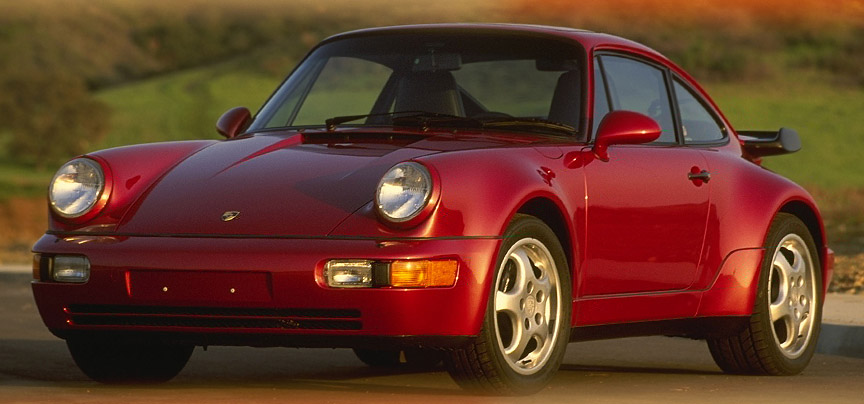
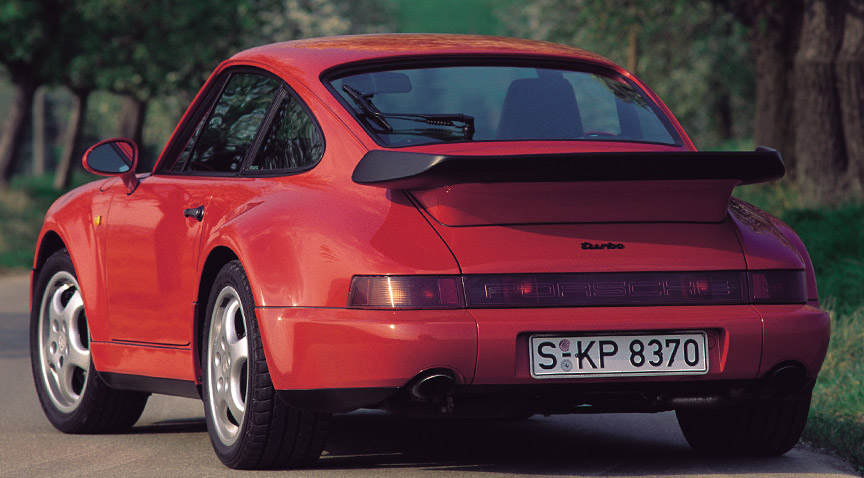
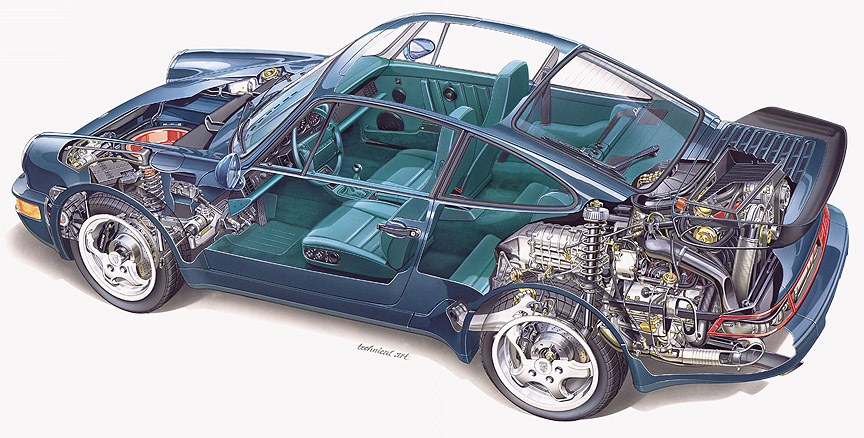
The production of the 235 kW 964 Turbo started in late 1990. At the time of the change of the year (12/1990-1/1991) the 964 Carreras finally got new engines with gaskets between the cylinders and heads eliminating the leakage problem seen in the earlier cars. The good engines start with the engine number 62M06837 for manual and with 62M52758 for Tiptronic cars.
The 964 Turbo arrives in USA a bit later, but is immediately entered into 1991 IMSA Bridgestone Supercar Championship from its second round on June 30 at Watkins Glen. Hurley Haywood wins the first event entered and by the end of the season also the championship for Brumos Porsche racing team. In Europe the 964 Turbo 3.3 is also available with 261 kW (+26 kW) X33 WLS powerkit (WLS stands for Werks Leistungssteigerung = factory power increase).

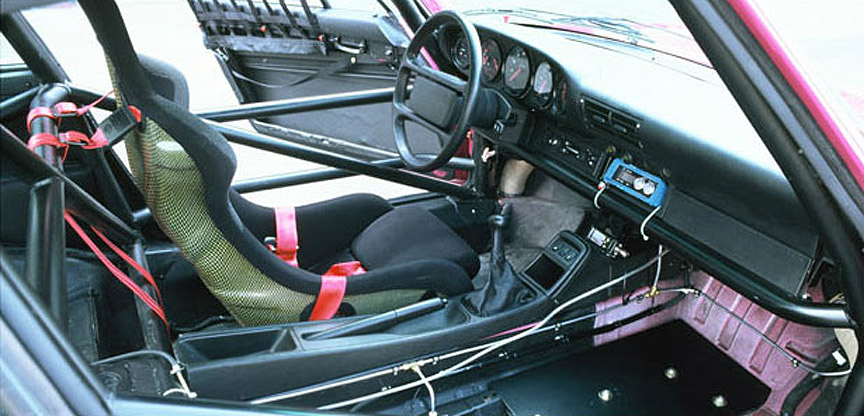
For the 1992 model year the company had a lot of news for its customers. In the best handling car category the 944 was replaced with the 968 and in the GT category the 928 S4 and GT were replaced with the 928 GTS. The 911 Carrera 2 Cabriolet Turbo-look became available. The bumpers, fenders, sidesills, brakes and 17″ wheels were from the Turbo, but the Turbo-look cars didn’t get the rear wing of the Turbo.
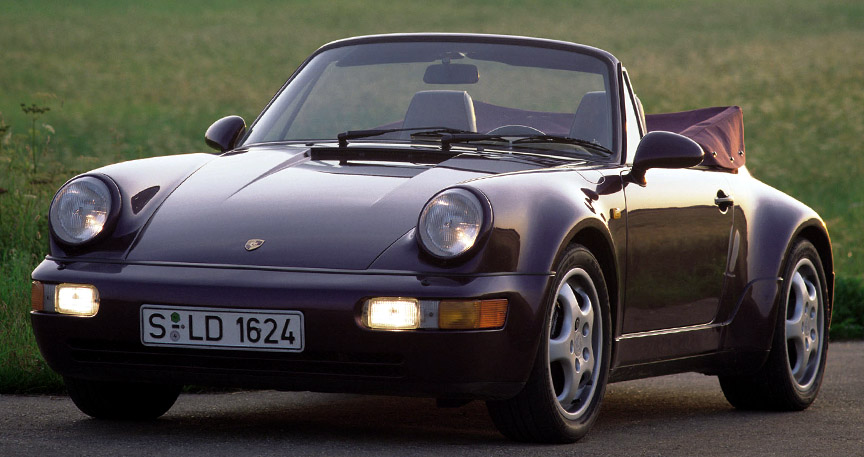
As from 1992 USA required to have 3-point seat belts also for the rear occupants and Porsche couldn’t install 3-point belts in the back of its 964 and 968 cabriolets, the cars for USA were made without rear seats. A luggage compartment was installed instead of the rear seats.
An open car with only two seats is called a roadster, and not a cabriolet, so all open Porsches made for USA were now actually roadsters. The 911 Carrera 2 Turbo-look was sold in USA as the “America Roadster”, but the narrow body versions were still sold as “Carrera 2 Cabriolets”. As the sales to Canada were also managed by Porsche Cars North America (PCNA), the Canadian cars had US VIN codes, but interiors of the European models, with kilometre speedometers and rear seats. Therefore, the widebody cars sold in Canada were called as their European versions: 911 Carrera 2 Turbo-look Cabriolet. One of the America Roadsters with Tiptronic gearbox was so extensively modified by the Porsche Sonderwunsch (Porsche Exclusive) department that it received a special designation: America GS.

The aero mirrors introduced a year earlier on the 911 Turbo, were now standard on all Porsche models including 968, 911 and 928. The 17″ Cup-style wheels were standard on widebody 964, 928 GTS and optionally available for 968 and narrow-body 964. Carrera 2 finally got decent brakes at the rear (now same as 964 C4, originating from 944 Turbo). The airbags that were standard for the US-models, were now standard in European models as well (in Europe they were optional up to MY1991). Porsche was the first car maker in the world that had both front airbags available for all its model lines.
The street version of the 964 Carrera Cup race car, the Carrera RS was in the plans from early on and the Carrera RS prototype was shown on September 17, 1990, at the Birmingham Motor Show. The production-ready version was shown at the Geneva Motor Show in March 1991 and the production started in September 1991 as 1992 model. It was available in three forms: Lightweight, M002 Touring and M003 Competition. When the early Cup cars were based on the Carrera 2, starting from MY1992, the Cup cars were based on Carrera RS. The MY1992 Cup cars have 7 kW more power. Option code 001 (M001) was allocated for Cup cars based on RS cars. Compared to the Carrera 2, the shell of the Carrera RS was strengthened with additional hand-crafted seam welding, there were no rear seats, aluminium front lid was fitted along with thinner side and rear window glass, lightweight rear bumper and magnesium Cup wheels in the sizes of 7.5/9.0-17″ which saved 10.6 kg/22 lb. For comparison the Turbo had 7.0/9.0″ and Carrera had 7.0/8.0″ Cup-style aluminium wheels. So the rear wheels were as wide as in the widebody Turbo and the front wheels even wider, despite the Carrera RS having the narrow bodywork. The 964 Carrera Cup, Turbo and RS all have big brakes. Confirmed by the Porsche racing drivers, the steering was heavy as there was no power steering in LHD cars (RHD cars did have the power steering).
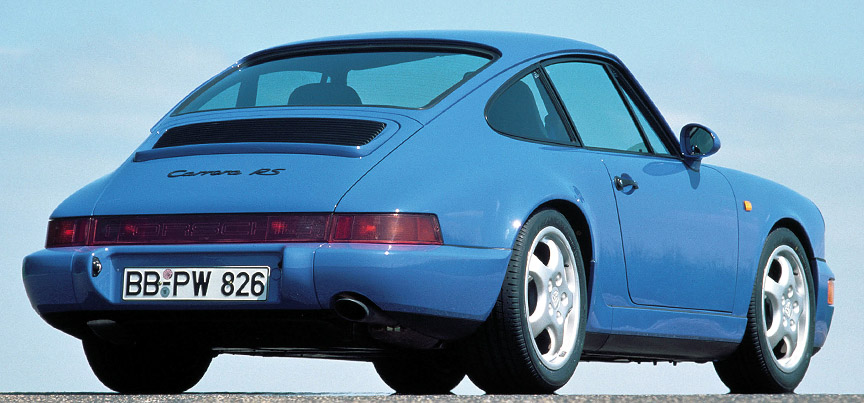
In addition to the basic lightweight model the Carrera RS was available with option M002 Touring package. With this came dual mass flywheel, standard wiring, sports seats instead of buckets, regular doorpanels, rear window heating, electric windows, alarm, central locking, interior lights, electric mirrors, full trunk carpeting, sound deadening, undercoating, large windshield washer bottle etc. making it 100 kg / 220 lb heavier (almost as heavy as the Carrera 2). In addition for the Touring model the AC, seat heating, radio, headlamp wash and sunroof were optionally available. The Touring version was a poser’s car – ‘RS’ on the rear lid and and harsh suspension, but basically a Carrera 2. With the Touring package most of the things that were eliminated from the Carrera 2 to make the RS, were installed back. While with the M002 option you destroyed the nature of the Carrera RS, with the M003 Competition option you could take it even closer to the M001 Carrera Cup car. The M003 Competition version was somehow street legal. In comparison to the Lightweight version, the M003 had no engine compartment insulation, no trunk carpeting, no interior carpets, no headliner, sunvisor on driver’s side only and a rollcage installed (it was optional for basic lightweight version, but standard for M003).
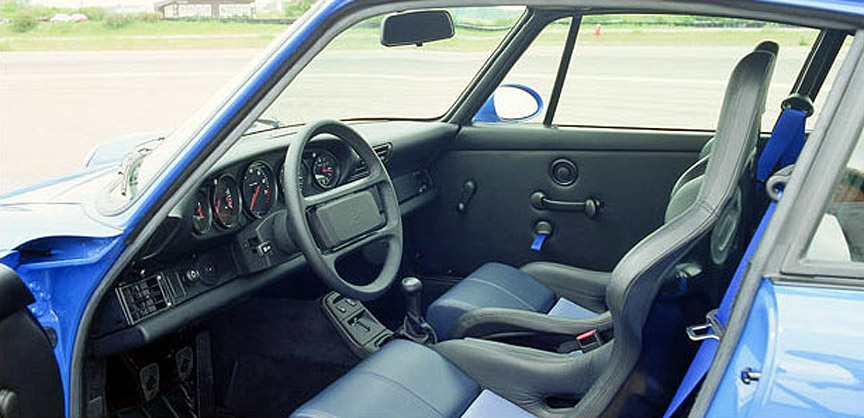
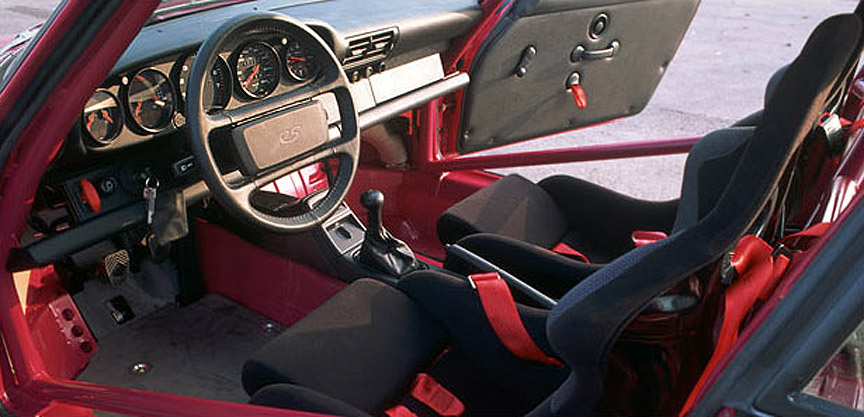
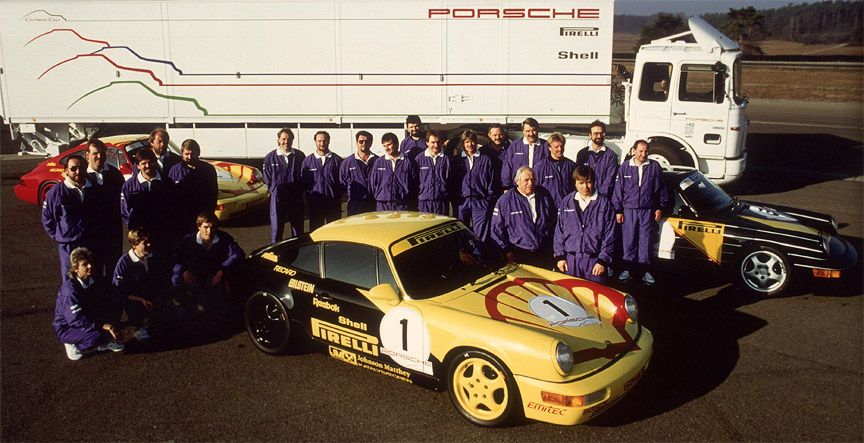
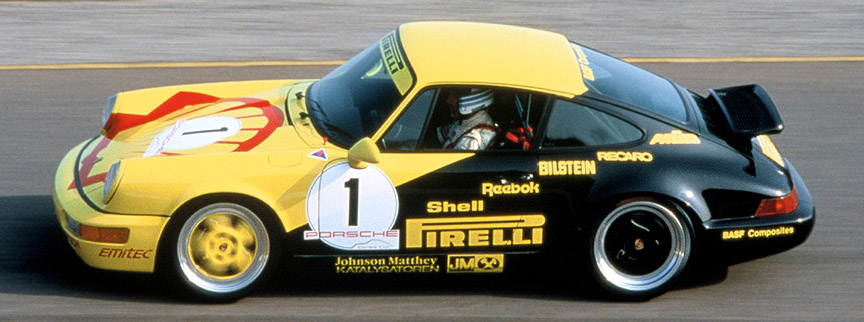
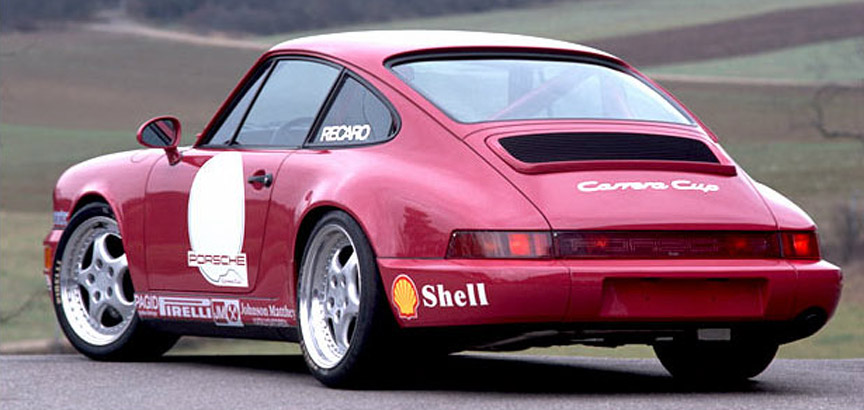
For the 1992 season there was an idea to introduce the Carrera Cup also in the USA. US customs looked at the Cup cars as street cars and so they had to meet Environmental Protection Agency (EPA) and Department of Transportation (DOT) laws. It was not possible to import the Carrera Cup cars and not even the Carrera RS cars into the USA. The solution was to fit Carrera RS cars with airbags, electric windows, alarm system, American lighting, American bumpers, aluminium wheels, and standard seats. This all just for the import procedure. After the cars were declared in to the country, they were converted to racing cars at Andial. The Carrera Cup USA racing series was to function as a support race for the CART racing series. 45 cars were imported and after 25 of them were converted to racing cars, it was clear that the series is too expensive for the teams and without enough sponsors, the series was cancelled before it began. The 25 cars were converted back to street trim and all of the 45 cars were silently sold through the Porsche dealer network. These cars were approximately 90 kg/200 lb lighter than normal Carrera 2 US-versions.
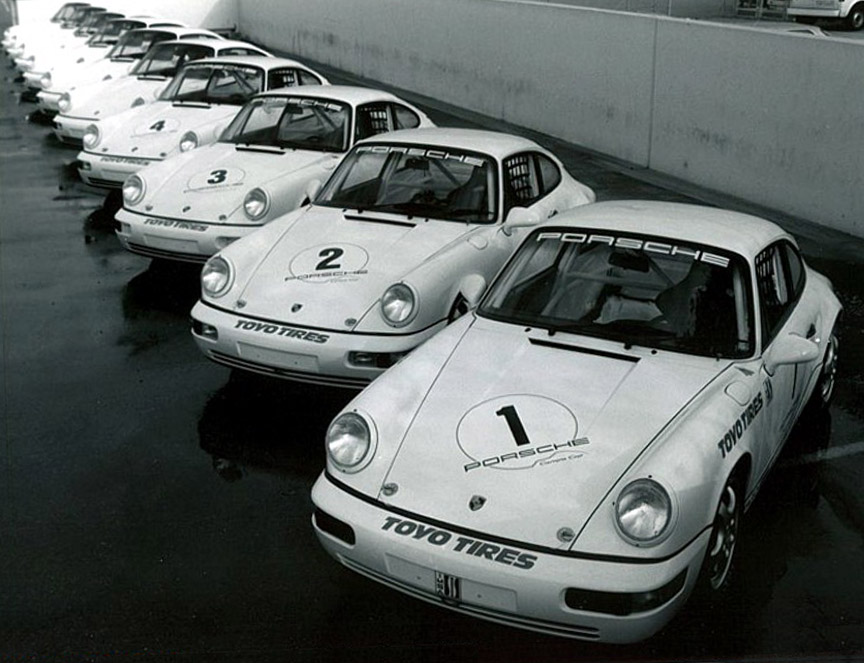
Porsche Cars North America being desperate about the sales, showed a new 911 modification in January 1992. It was called “RS America” and as a marketing trick it was immediately sold as a 1993 model (although Porsche’s next model year started in August). Its visual distinction was the whale tail rear spoiler, the ‘RS’ decals on the sides just in front of the rear wheels, and the 17″ wheels were fitted as standard on this model. It had a sports suspension, but with US-model standard ride height. To reduce weight, the power steering was deleted, mirrors were manual, flat door panels were fitted from the European RS, radio and AC were made optional (otherwise standard in US Carrera). Cruise control, seat heating and headlamp washer were not available at all (were optional for Carrera). For some reason the rear seats were replaced by the luggage shelf for MY1993 (cannot see weight reduction here), but they were back for the 1994 model. The front seats were cloth covered sports seats. The RS America was listed by PCNA as weighing 2954 pounds (1340 kg), 77 pounds (35 kg) lighter than the weight listed for the stock US Carrera 2 (which was heavier than the European C2). The RS America had standard C2 brakes, engine and gearbox.

In June 1992 in Weissach started the limited hand-made production of the 1993 model year 964 Carrera RS 3.8. Compared to the Carrera RS 3.6, the power was up by 30 kW (221 kW). In addition to the aluminium front lid, the doors are also of aluminium on the 3.8-litre RS. Like the Carrera RS 3.6, the 3.8 didn’t have power steering. The car was lean enough for the 3.8 engine to propel it from 0 to 62 mph/100 km/h in 4.9 seconds and to the top speed of 168 mph/270 km/h. The weight with fuel is 1210 kg/2668 lb and that is 140 kg/309 lb down from the European C2. Dry weight is only 1140 kg/2513 lb. The front brakes of the Carrera RS 3.8 are bigger than those in the RS 3.6 and the rear ones are the same, just that the calipers are now painted red. The RS 3.8 was optionally available with radio and driver or both front airbags or with the M003 Clubsport safety package (roll cage, fire extinguisher and 6-point harness).
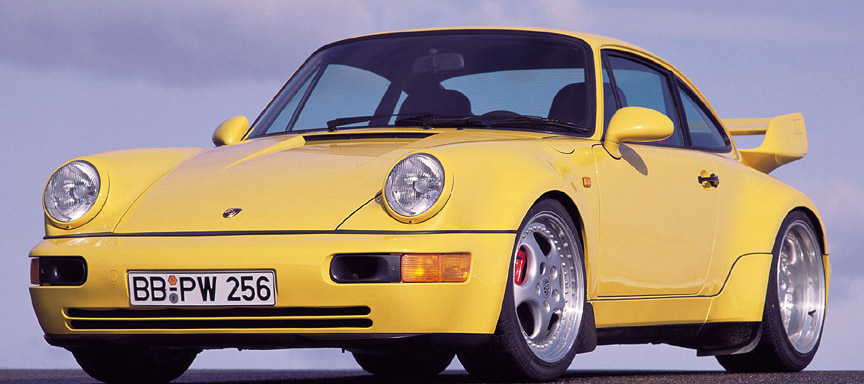
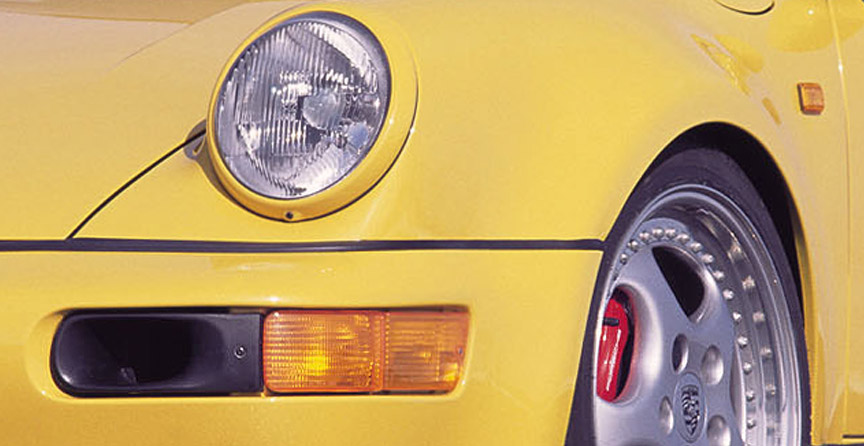
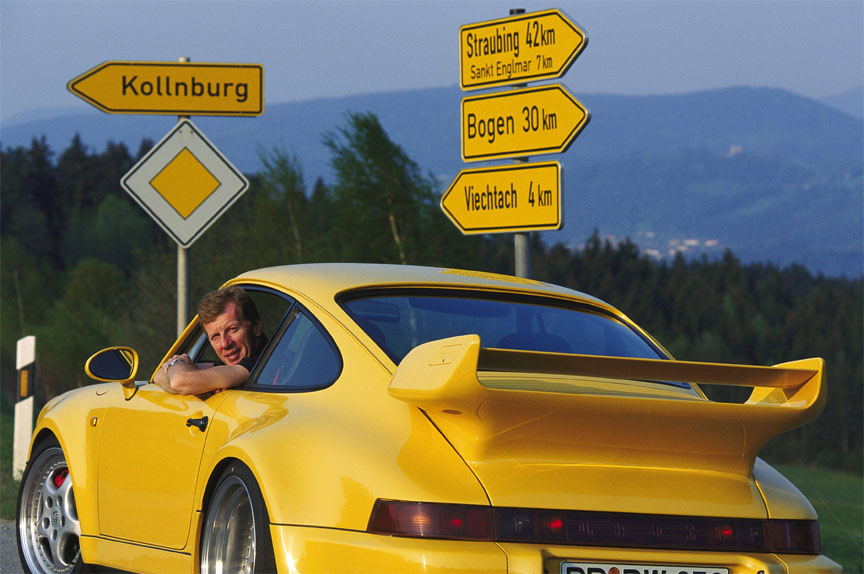

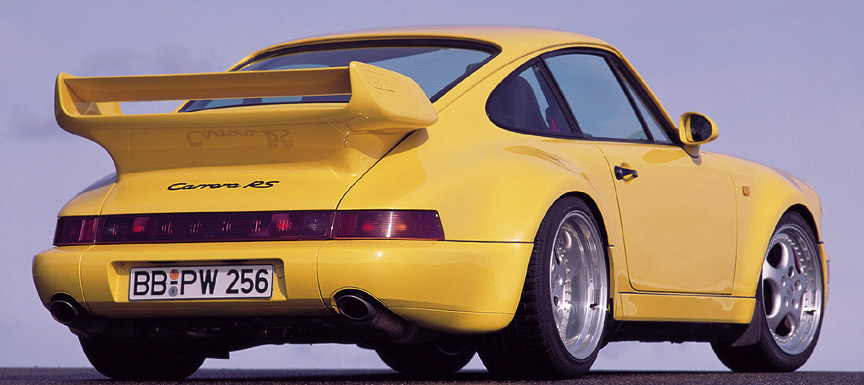
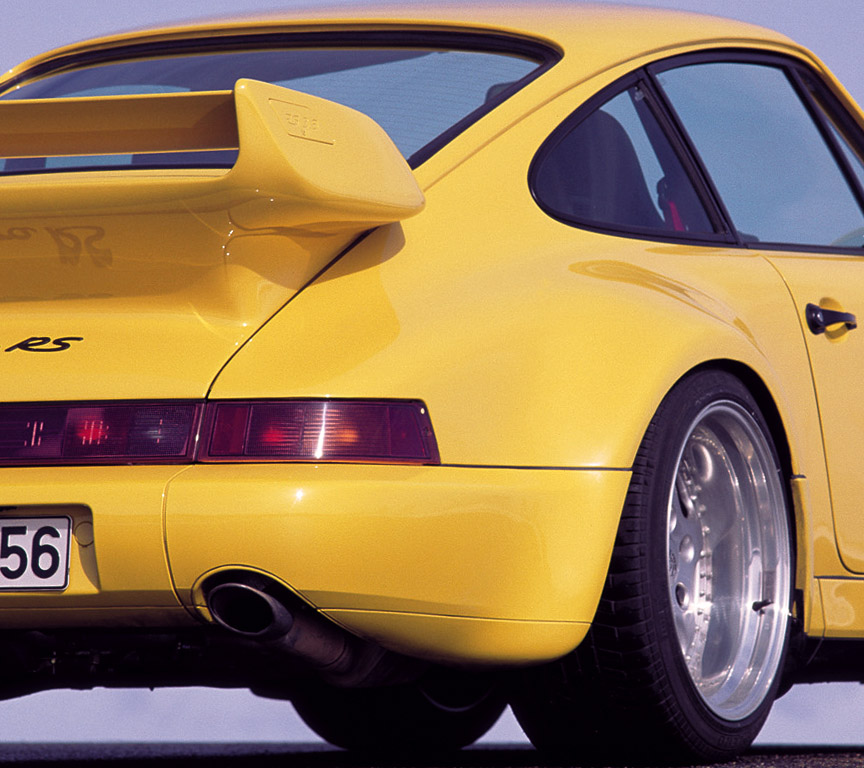
The reason for the Carrera RS 3.8 was to homologate the Carrera RSR 3.8. It was created for the next season (1993) 24 hour races and ADAC GT Cup. According to ADAC GT Cup Division 1 rules of 4 kg/PS formula, Porsche had to rise the weight from 1120 to 1300 kg and detune the engine from 350 PS/257 kW to 325 PS/239 kW.
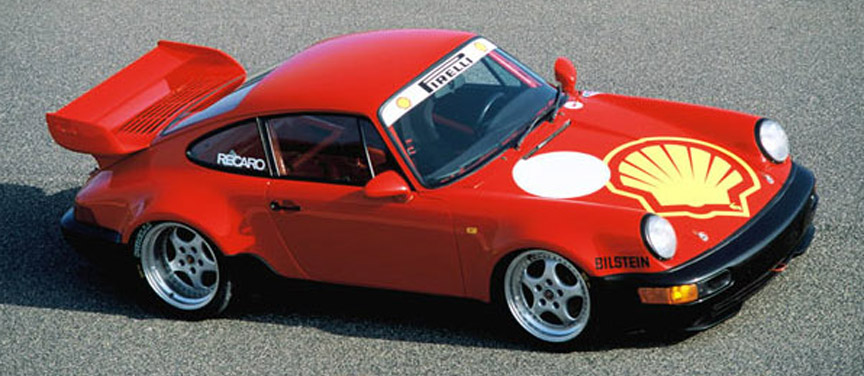
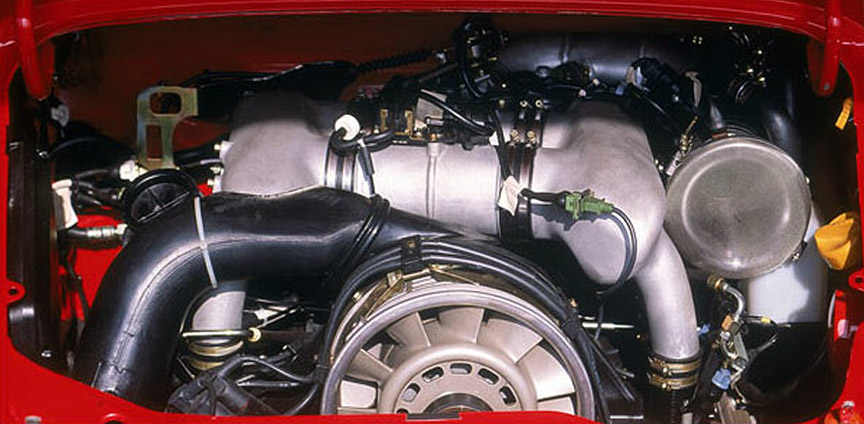
The total production of the RS 3.8 was 55 cars and RSR 3.8 51 cars.
In 1992, one of the best Porsches ever, the 3.3 litre Turbo S was introduced as 1993 model. It was a mix of 964 Carrera RS and 964 Turbo – a very light car with Turbo’s wide body and modified engine to produce 280 kW. It was one of the fastest cars on the road. Like the Carrera RS, it didn’t have comforts and steering was without servo. Lightweightness was the recipe for the first and the ultimate 911 Turbo S, but that was soon forgotten (the following Turbo S models all were the heaviest 911s at the time of production). The first and original 911 Turbo S 3.3 created in 1992 was a car to dream of.
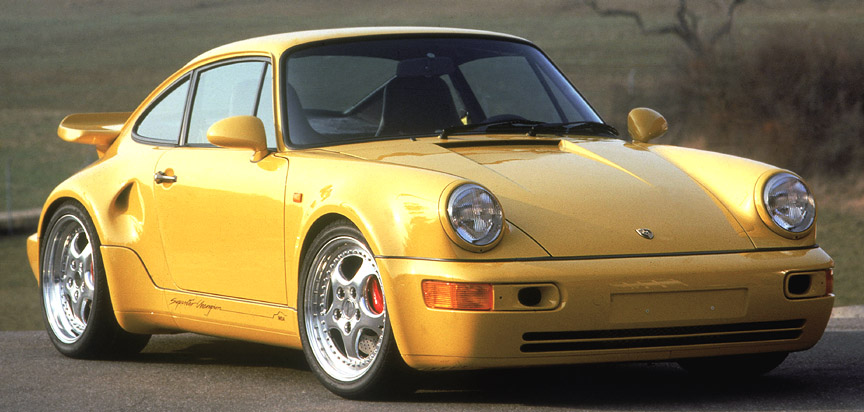

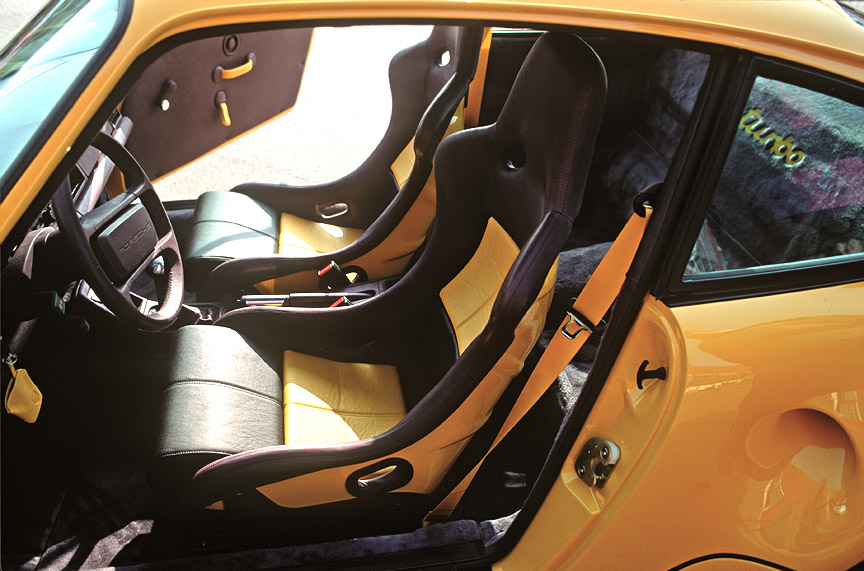

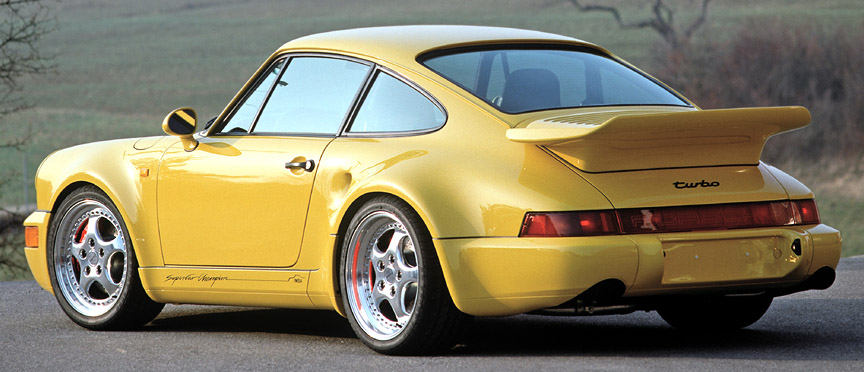
In the middle of the 1992 IMSA Supercar Championship the racing 964 Turbos were equipped with powerkit and the cars were called 911 Turbo S2. The first Turbo S2 entered a race on July 17, 1992 at Laguna Seca in the hands of Hans-Joachim Stuck. Hurley Haywood was running the original car in this race and after a week they both already had Turbo S2 cars at the Portland race.
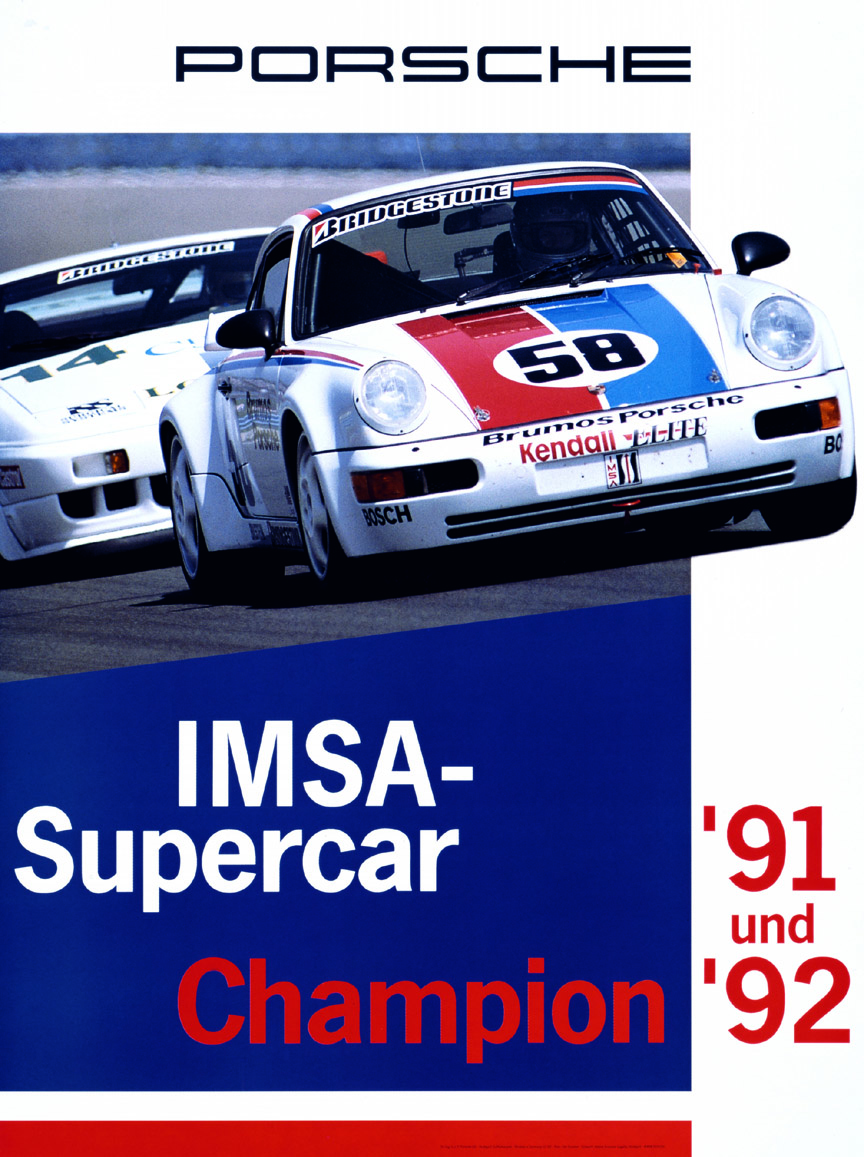
Due to different reasons, the 261 kW powerkit for the Turbo 3.3 nor the 280 kW Turbo S 3.3 weren’t available for US customers. What PCNA did was to order Andial in the end of 1992 to convert the engines of the twenty 3.3 Turbos. Not to catch the attention of EPA and DOT, the TS2 powerkit had 240 kW (+5 kW) on the paper. The powerkit installed wasn’t the one that converted European cars to 261 kW, but more likely the modifications seen on European Turbo S 3.3 with 280 kW. PCNA marketed the modifed cars as Turbo S2 (like the IMSA cars used from the middle of 1992). This was not an official name from Porsche as wasn’t the name of the powerkit – TS2. As the larger turbocharger had much longer lag, the car was a bit slower in acceleration up to speeds of 100 mph. The top speed was naturally higher compared to the regular 235 kW Turbo 3.3. While the European Turbo S 3.3 was a lightweight car, the Turbo S2 had the usual US equipment meaning the European ‘S’ was hundreds of kilos or pounds lighter.
Porsche released the 964 Turbo 3.6 in the beginning of 1993. It featured a turbocharged version of the 3.6-litre 964 Carrera M64 engine, but still fitted with ancient K-Jetronic fuel injection. The normally aspirated 911s had electronic fuel injection from 1983, when the Carrera 3.2 appeared and 944 Turbo had electronic fuel injection since its launch in 1985. The 3.3-litre G-model 911 Turbo didn’t get the electronic fuel injection, neither did the 964 Turbo 3.3 or 3.6. Go figure! Compared to the 3.3-litre, the Turbo 3.6 had 29 kW more, now 265 kW. Compared to the 3.3 WLS, the 3.6 WLS also had 29 kW more (now 283 kW). Less than 1500 Porsche 964 Turbo 3.6 cars were made, making it one of the rarest Porsches produced. For the 1993 IMSA Supercar Championship season the 911 Turbo 3.6 was also used.
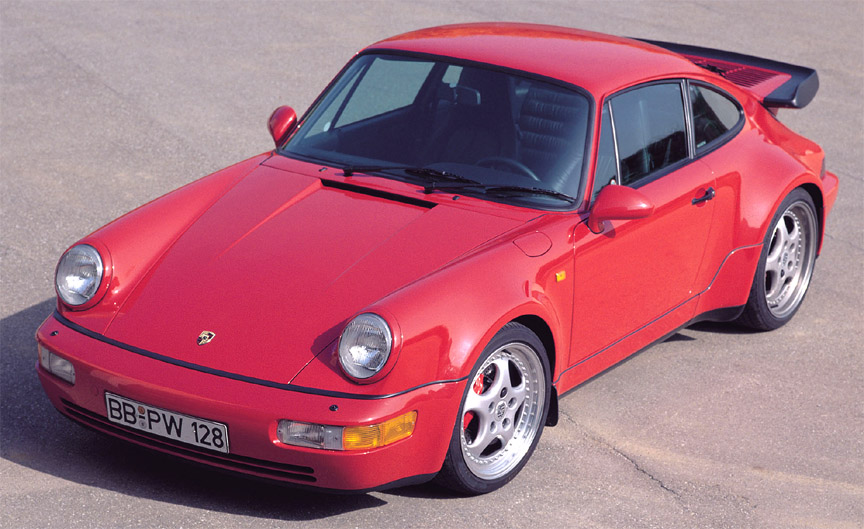
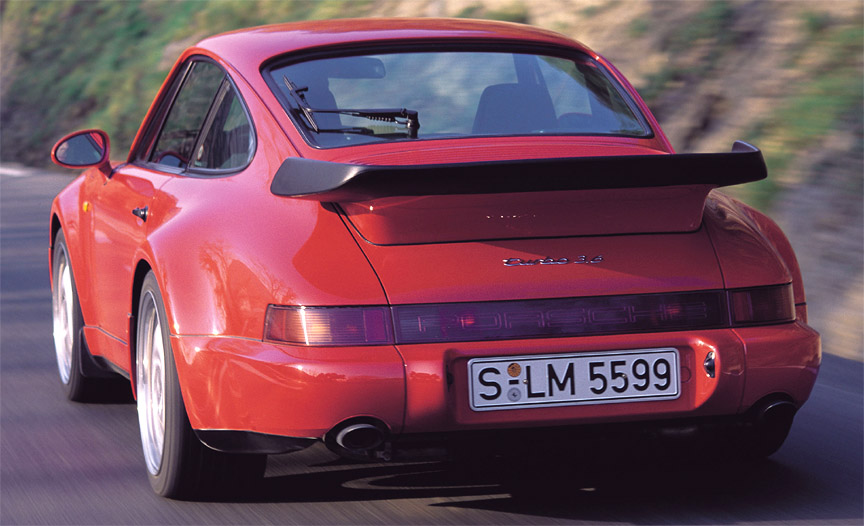
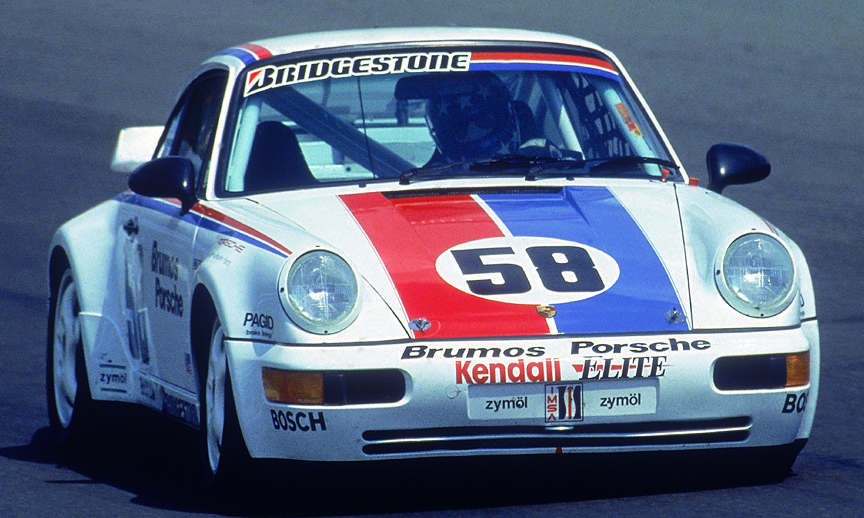
As Porsche was in need of cash, the 30 years 911 anniversary model was launched in advance, introduced at the Geneva Motor Show in March 1993. The prototype of the original 901/911 was introduced in September 1963 as 1964 model and the production started in the end of 1964 as 1965 model, so the 1993 model 964 Carrera 4 Turbo-look ’30 years 911′-anniversary model arrived 29 model years after the introduction of the prototype and 28 model years after the actual production started. There were 911 cars of the anniversary model made, with around 84% of them being Viola dark purple metallic (usually with Rubikon gray leather), ~14% Silver (usually with black leather) and ~2% Amethyst violet-purple metallics. The M096 ‘Jubiläumsmodell’ was produced during model years 1993 and 1994.
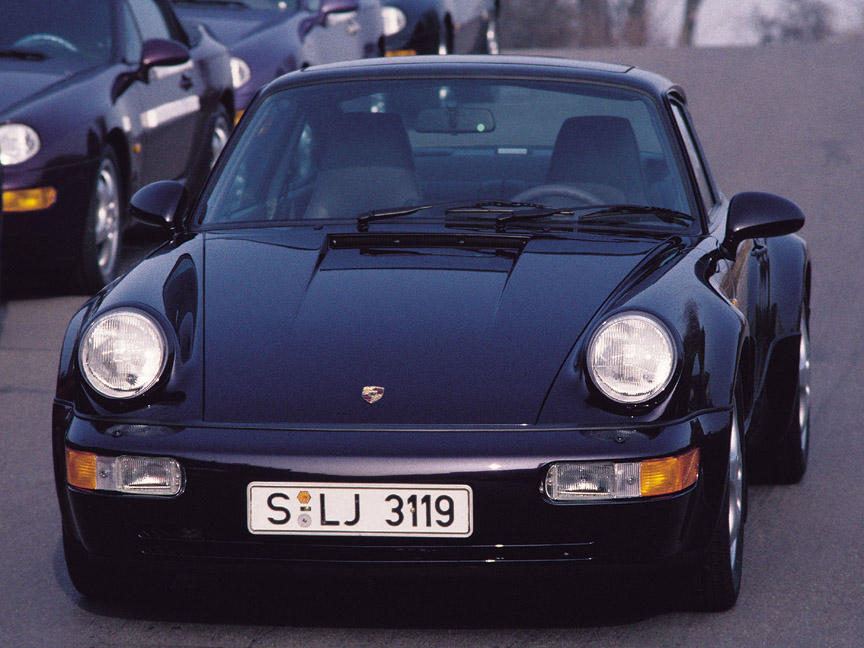
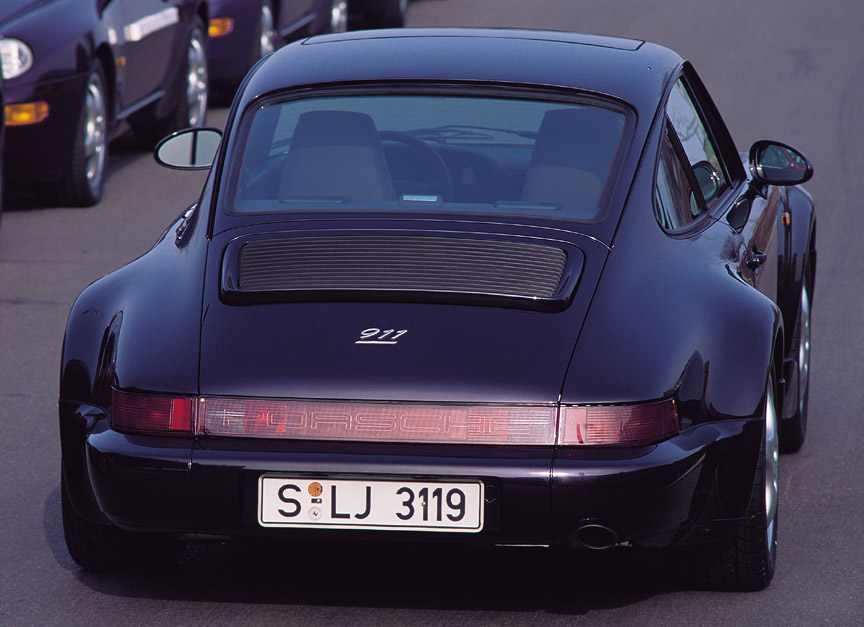

For the 1993 season, a special racing car was created. The 964 Turbo S LM had a 3.2-litre engine which developed 349 kW with two 34 mm air restrictors. Lightened from the already light Turbo S, the Turbo S LM was reduced to 1000 kg/2200 lb (weight minimum set by the rules). The car was created with 1993 Le Mans 24H in mind, hence the abbreviation “LM” in the name, but first used for the Sebring 12H in March, where it took class win (7th overall), piloted by Walter Röhrl, Hans-Joachim Stuck and Hurley Haywood. With the same drivers at Le Mans 24H in June the car was leading its class, but had to retire due to an accident.
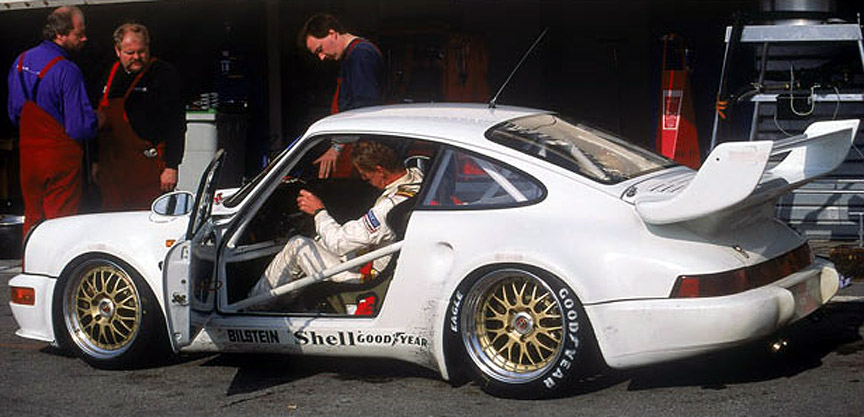
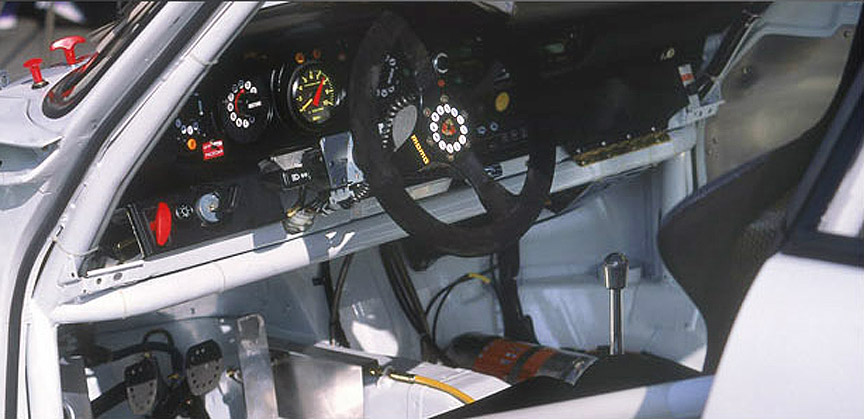
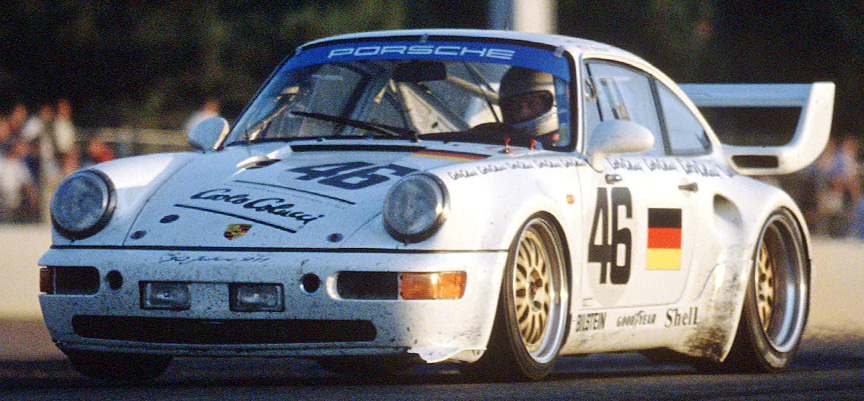
While in 1991 Carrera Cup France was also started, for the 1993 season the Porsche Supercup series was also created. The difference between the Carrera Cup and the Supercup wasn’t big – Carrera Cup was a national series and Supercup events were international, mostly run before the Formula 1 races. The cars were basically the same, just that it took more money and offered more fame when participating in Supercup. Interestingly, with a tuitition from Walter Röhrl, guest driver Mika Häkkinen won the 1993 Supercup race in Monaco although he had no previous experience with the 911. Some drivers even participated in both series in the same season. For example, the 1993 Supercup winner Altfrid Heger scored second in Carrera Cup Germany on the same season, which meant he raced almost every week.
In the summer of 1993 Porsche Exclusive (Sonderwunsch) department created six 964 Turbo 3.3 Cabriolets. It was an easy job – a C2 Turbo-look was equipped with the rear spoiler and turbo engine (note: Turbo 3.3, not 3.6).
As the 30 years 911 anniversary model had not been available in the USA, for the MY1994 the Carrera 4 Turbo-look Coupé was also sold in the USA, but without the M096 Anniversary model option. All European model C4 widebodies were M096.
With the 964 production nearing its finish, the Speedster was launched in the middle of 1993. The 964 Speedster was sort of an open top Carrera RS, with -70 kg/154 lb weight reduction compared to the European Carrera 2 Cabriolet. Around 15 cars were also made with the Turbo-look body by Porsche Exclusive. For these cars, 964 Turbo brakes were also an option.
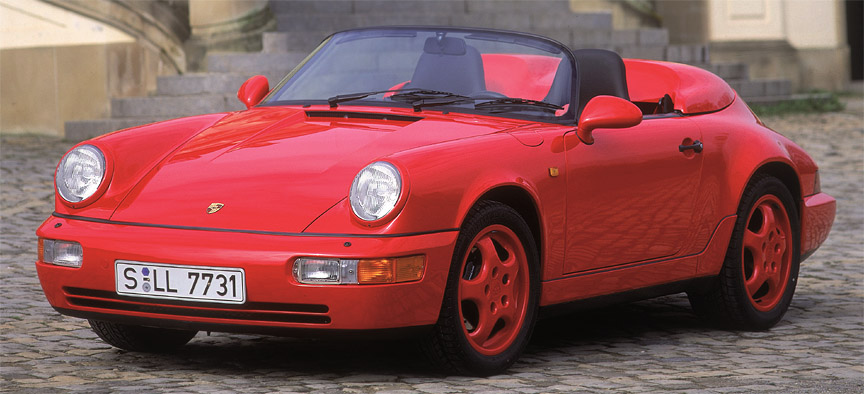
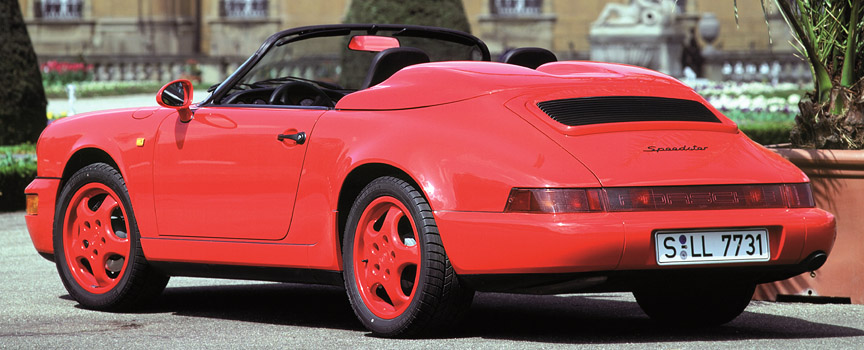
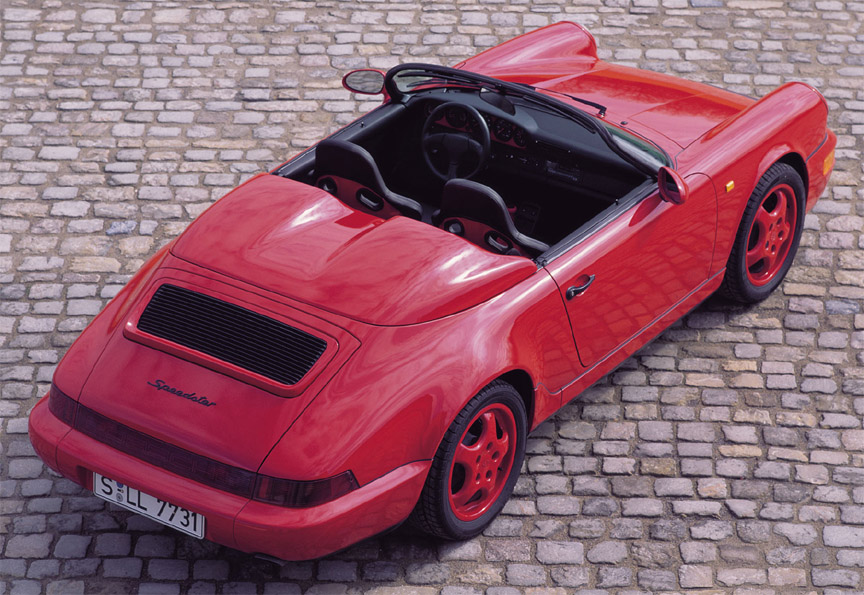
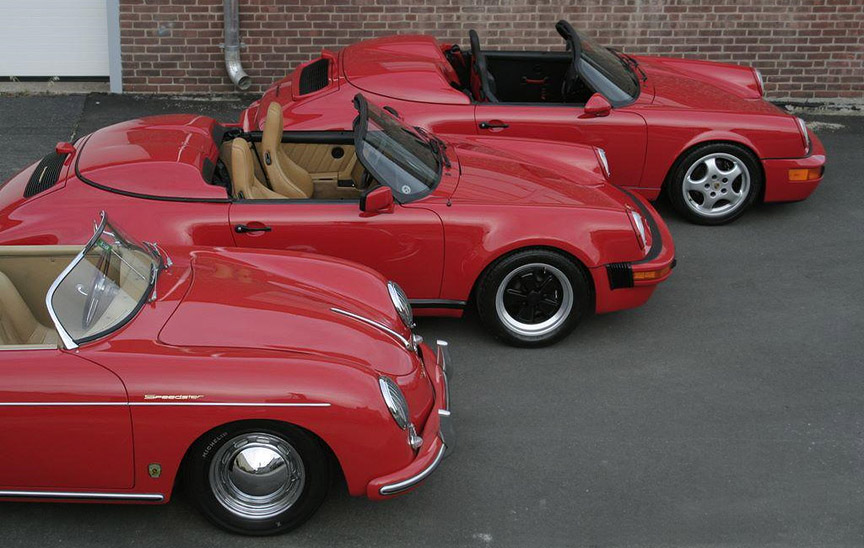
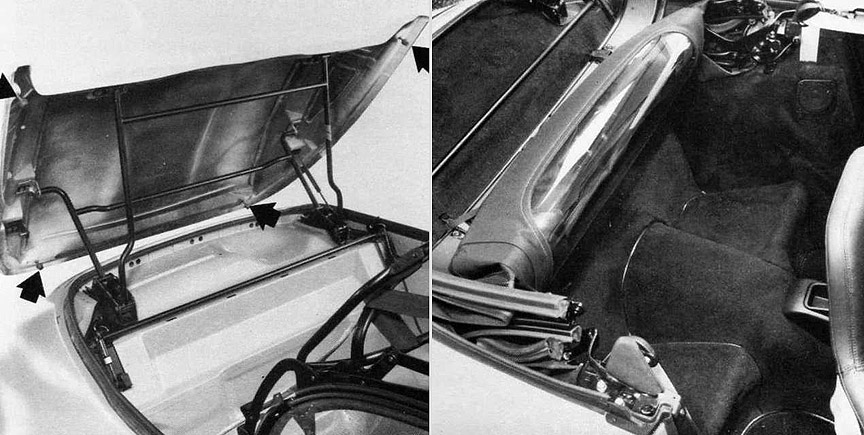
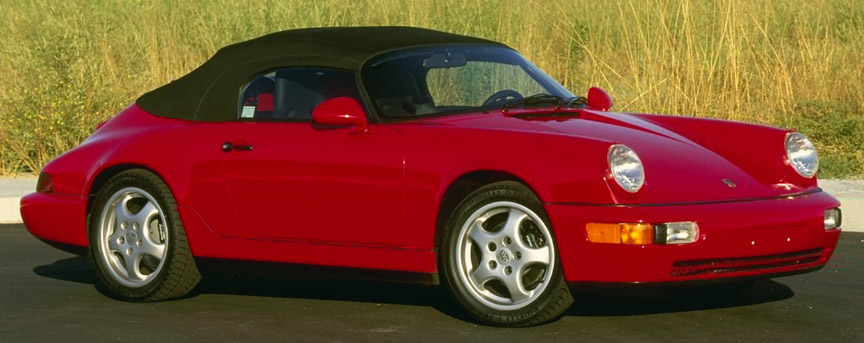
In August 1993 Porsche announced that they will build a few Slantnose (also called Slopenose, Flatnose, Flachbau) 964 Turbos around the year change. While the version for Japan, the X83, got the G-model Slantnose front wings and side design, the X85 US-version and X84 Rest of World-version had the 968-style pop-up headlights. The wheels were 3-piece Speedlines 8+10×18″ with 225/40 and 265/35 tyres. The 964 Turbo 3.6 Slantnose version included the X88 powerkit and was 60% more expensive than the standard Turbo 3.6. Official performance data for the X84 ROW model reads as follows: 280 kmh / 174 mph, 0-100 kmh/62 mph in 4.7 seconds, 1 km from standing start in 23.3 seconds, 1470 kg/3240 lb.

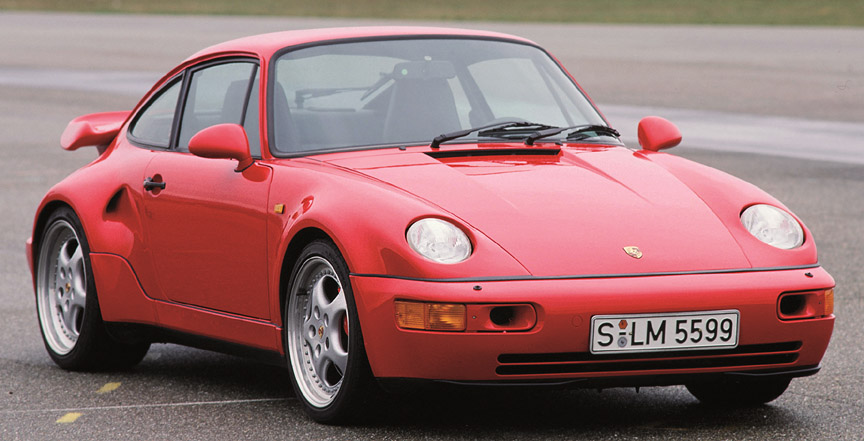
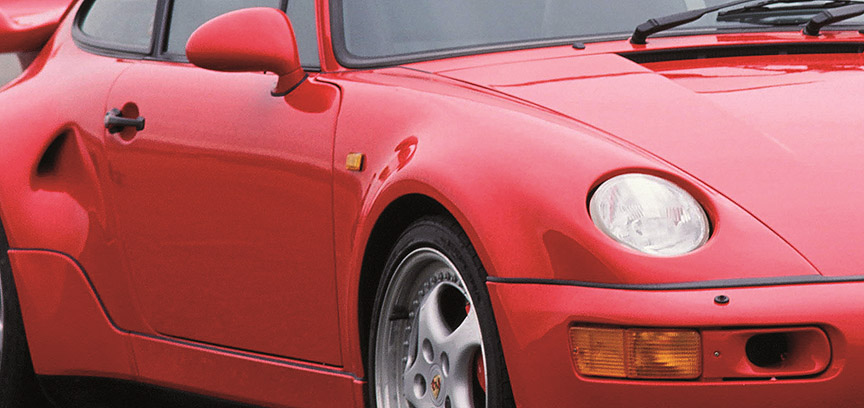
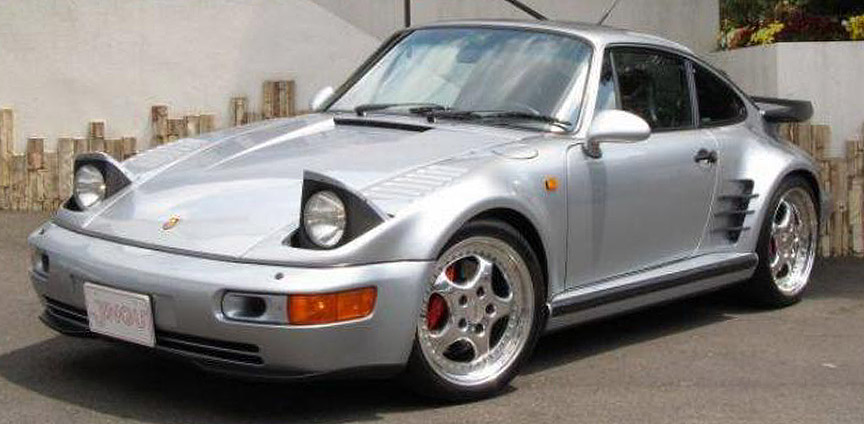
In addition to the Slantnose cars there was a 964 Turbo 3.6 “Package”-version made for USA, which incorporated many X-goodies from the price list of Porsche Exclusive. No wonder, the “Package” cars are sometimes referred to as 964 Turbo S 3.6 as they have the X88 powerkit, X92 Exclusive front spoiler lip, X99 Side air inlets for engine cooling and the X93 Exclusive rear spoiler.
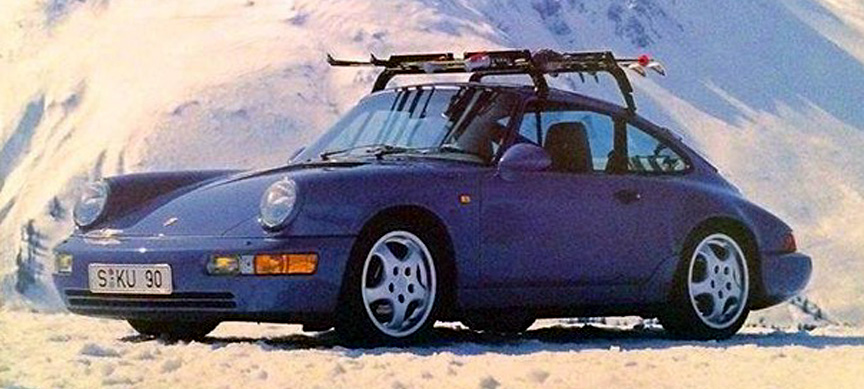
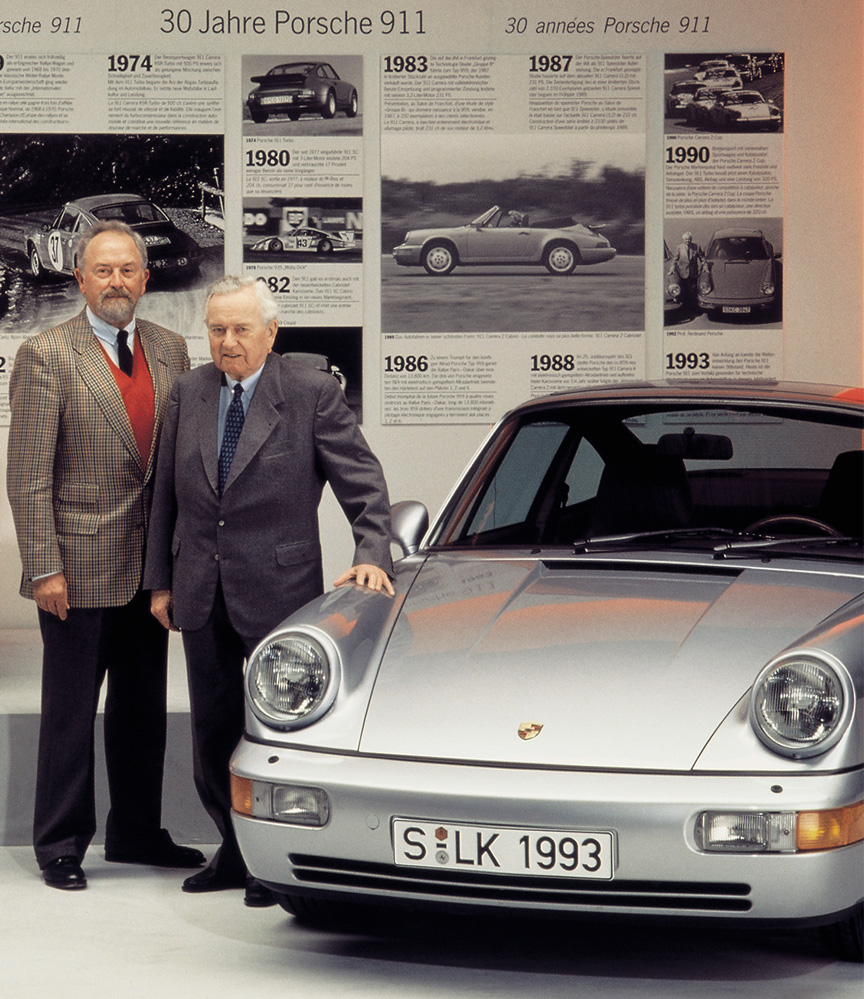
With the end of the 964 production, the last classic Targa was produced in the form of a MY1994 911 Carrera 2 Targa. The “safety cabriolet” was in production since MY1967, for 27 years! While the last special versions of the 964, the Speedsters and flatnose Turbos were made, the production of the next generation 911, the 993 had already started in the end of 1993.


